Dairy farmers in Kenya are being hit hard by climate change.
The country is seeing increased droughts, and, with dry spells projected to increase up to 27% in severity and heat waves likely to increase in duration by up to 30 days, climate change will continue to exacerbate the multitude of challenges farmers and their families face.
Access to water is key for dairy farmers and is a significant challenge in Kenya, especially in rural areas where the majority of the population lives. 76% of households in rural areas do not have piped water access, and spend an average of 3.5 hours per week fetching water (KIHBS 2018).
Continuous access to clean water is vital for dairy production, with an adult healthy dairy animal requiring about 75 liters of water daily, animals can die without water in 2-3 days. Increased herd movement to water sources impacts cow health and also imposes a substantial time burden, particularly for women and girls, with negative consequences such as dropping out of school.
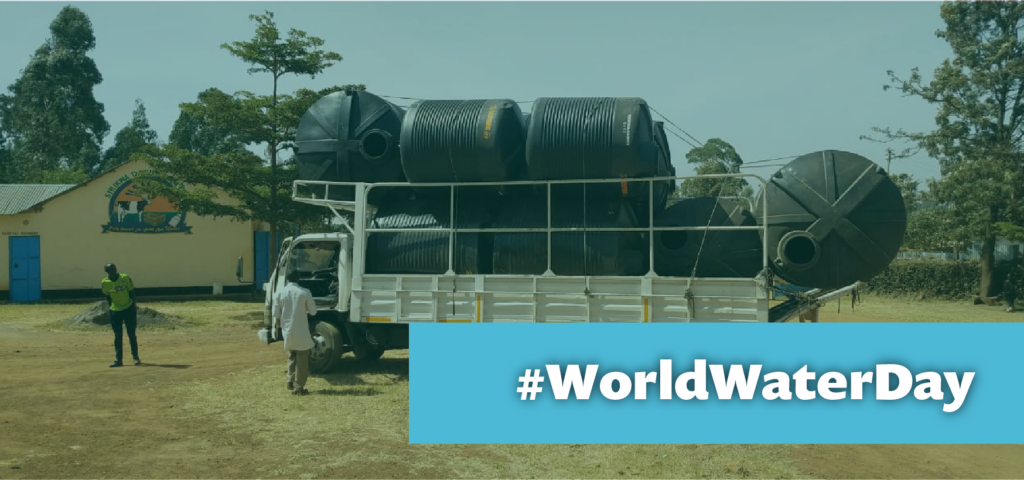
With changing weather patterns and unpredictable rainfall, rainwater harvesting can provide a sustainable source of water for agriculture and livestock production. This is particularly important in dairy farming, as water scarcity and poor-quality water can lead to decreased milk production and health issues in dairy animals. Large water tanks are an efficient method for storing harvested rainwater.
However, financial constraints limit smallholder farmers’ ability to invest in rainwater harvesting tanks for climate adaptation and improved dairy productivity. Lack of access to credit, limited financial resources, and competing household expenses are major barriers to investing in water storage tanks.
Against this backdrop, PxD’s program on Asset Collateralized Loans (ACLs) for water tanks presents innovative financing mechanisms to address water scarcity and liquidity bottlenecks to improve climate resilience and dairy productivity in developing countries.
How dairy ACL works
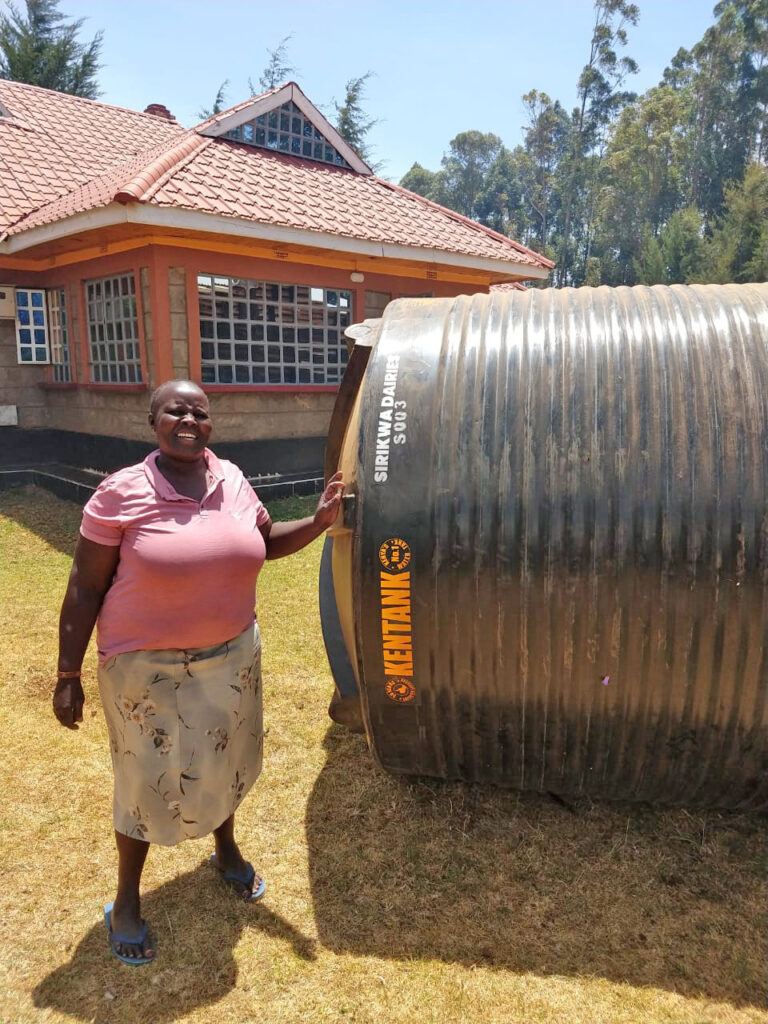
Water tanks pose a unique financing opportunity. They are large and difficult to move, and they retain their market value over time, meaning the assets themselves can serve as the collateral for a loan.
This removes the need for guarantors, which often poses a significant barrier to access to credit. Repayment is made automatically from the milk income earned through milk sales from the farmers throughout the month. If the farmer was to default on the loan, the tank could be resold at close to the original value.
About 1.8 million smallholder farmers depend on dairy farming for their livelihoods in Kenya but a bulk of them are unable to obtain loans from traditional lenders, such as banks, because they do not have the collateral or credit history required.
The ACL approach, therefore, has several advantages over traditional lending methods, which often require extensive paperwork and collateral that many smallholder farmers do not have.
Our Research Project
PxD has been implementing a two-year research project on ACLs for water tanks in collaboration with the University of Chicago’s Development Innovation Lab (DIL) and two dairy cooperatives (Lessos and Sirikwa Dairies) in Kenya’s Rift Valley region.
A previous study (Jack et al., 2019) demonstrated strong evidence that the ACL model for water tanks could improve farming and household health, as well as well-being outcomes among smallholder dairy farmers.
The study, conducted in partnership with the Nyala Savings and Credit Co-Operative Society (SACCO), randomly offered some farmers the opportunity to replace loans with high down payments and stringent guarantor requirements with loans collateralized by the asset itself.
At the end of the study, default rates were extremely low (less than 1%). Milk sales to the cooperative increased by 6-10%. And, because of the increased water supply within households, girls spent 19% less time fetching water, and school dropout for girls decreased by 85%.
This new study aims to evaluate the impact of ACLs for water tanks on economic and household outcomes among dairy farmers in Kenya. The main outcomes of interest include milk production and milk sales, loan performance, dairy farming practices, water use, time use (particularly for girls and women), household welfare, and well-being.
Delivering tanks to farmers
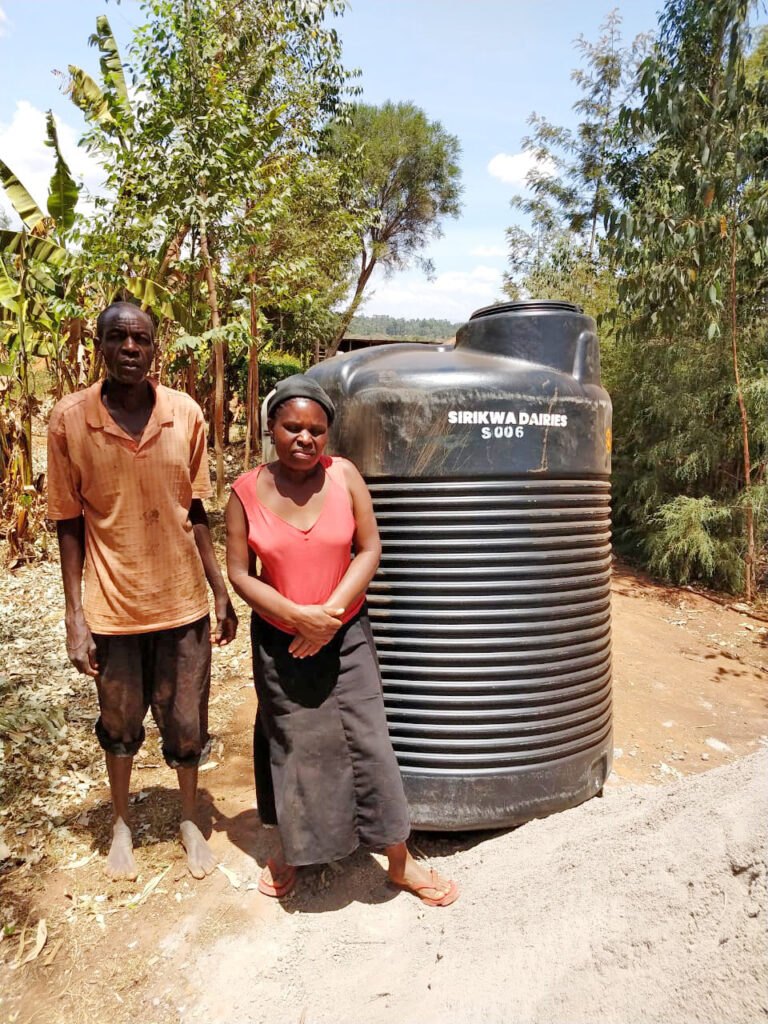
In partnership with the dairy cooperatives, PxD identified farmers that are eligible to receive the water tanks.
Eligible farmers need to pay an upfront deposit (currently 20%) to receive the tank, followed by monthly loan repayments over a two-year period. Farmers can choose between a 2500-liter or a 5000-liter tank depending on their needs. They receive the tanks at their doorstep for free, with a water tap that is ready to install. Starting from January 2023, PxD rolled out the tanks to a small group of 100 farmers. As of mid-March, 15 farmers had received the tank.
Farmers like Philip Too, a farmer from Sirikwa Dairy who has four dairy cows. Most of the people in his village rely on wells for their household water needs but unfortunately, they do not have sufficient water storage equipment. He is one of the few lucky farmers who are connected to electricity and thus he intends to fill his tank with water from a well within his farm using an electric water pump. With the tank, he hopes to have enough water to not only meet domestic needs for his family and livestock but also irrigate his small kitchen garden from which he expects to fetch some income by selling surplus vegetables to his neighbors.
Esther Sambai, a farmer from Sirikwa dairy, decided to get a 5000-liter capacity tank instead of a 2500-liter tank to meet the needs of her household and neighbors. She said, “My well does not dry up and many people in my village get water from my household for free in the morning when I am at home. As you can see, we pump water directly from the well and therefore I decided to get a bigger tank so that I can store enough water for my family and neighbors. With a tank, my neighbors will be able to access water even when I am away. I will also use the tank to supply water to my animals.” Esther has a solar-powered pump but before the ACL for water tanks, she did not have a water storage tank. The ACL has enabled her to finance a tank easily.
Way Forward
In the coming months, we plan to roll out the tanks to additional farmers (with the goal of reaching 750 farmers in total).
From our early interactions, we have learned that several factors influence take-up including time of the year, competing financial needs such as school fees, and low trust in new financial products which could limit farmers’ take-up of the product.
To address this, we hope to pilot low-risk ways of making the ACLs for water tanks more accessible, such as by lowering the deposit or offering a grace period. We will continue to test similar loan flexibility mechanisms until we can define a product that is interesting, safe, and accessible to farmers across contexts and geographies.
PxD is also making its first foray in Kenya into using low-power radio communications for remote sensing by experimenting with water sensors in this study. These sensors will allow us to measure real-time water levels for dairy farmers so that we can correlate supply, consumption, and dairy output. We hope this paves the way for us to explore the use of other sensors (such as those that measure soil moisture or air quality) to improve farmers’ access to real-time information.
Our first few months of rolling out water tanks have given us insight into the potential for ACLs to enhance credit access for productive assets by reducing the financial burden and collateral obligation that smallholder farmers typically face.
We believe this initiative can have a profound impact on farmers and their families in different contexts struggling with access to water, and could be a path not only to increase profits for farmers and the welfare of their livestock, but improve the well-being of women and girls who are those being most impacted by climate change.
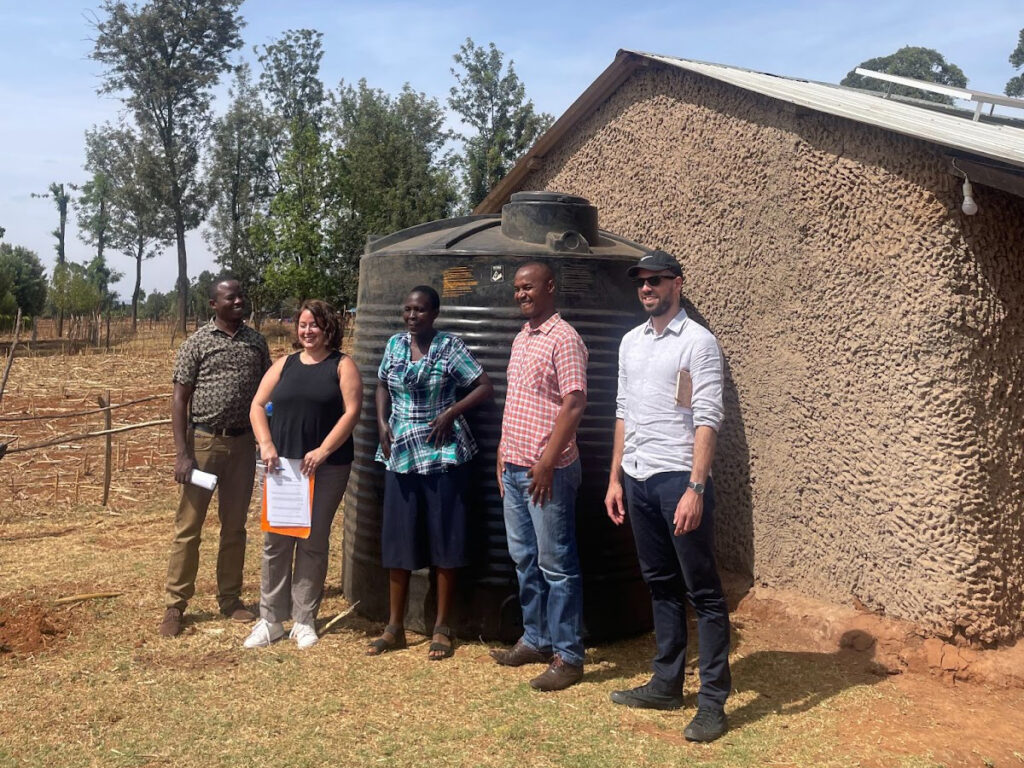
Paying people for actions that contribute to climate change mitigation, known as payment for ecosystem services (PES), has the potential to address both environmental and poverty alleviation goals. For example, there is a strong history of PES programs to reverse and slow deforestation in communities in the Global South. Emerging evidence of PES in the agricultural context also shows incentivizing smallholder farmers monetarily can be effective in encouraging behavior change for climate change mitigation.
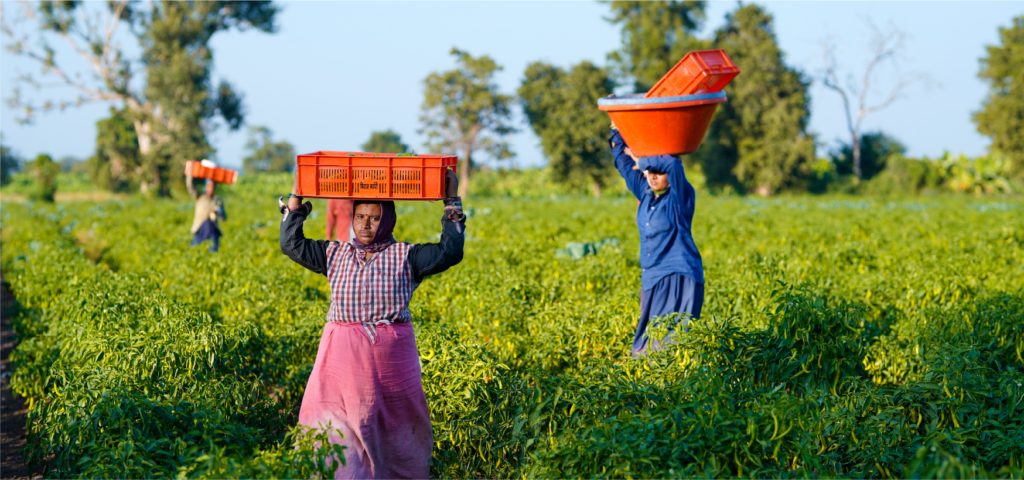
One way to finance PES programs gaining increasing interest from both the public and private sector is the voluntary carbon market, expected to be worth $50 billion by 2030. Connecting farmers to the amount of climate financing potentially available in the voluntary carbon credit market may help facilitate a sustainable agriculture transformation. However, a key variable still poorly understood is what the value of carbon credit prices should be to appropriately compensate farmers while also achieving carbon removal goals. The low and volatile prices of current nature-based carbon sequestration projects, ranging from $5–$15/ton of carbon from 2021 to 2022, can exacerbate the equity challenges PES programs face, especially in smallholder farmer contexts where ensuring procedural fairness and safeguarding the rights of smallholder farmer communities are critical.
There is currently little transparency into how prices for voluntary carbon market projects are determined, as well as the percentage farmers ultimately receive. As there is no standard system for carbon credit pricing, most pricing is determined between individual buyers and the specific project developer. If the buyer is a corporation that has set an internal carbon price, then there can be a degree of transparency in the price that the buyer is willing to offer for carbon credit projects. However, as the World Bank stated in a report on carbon pricing:
The market for credits from independent crediting mechanisms is heterogeneous, with buyers placing a range of values on characteristics such as the sector (e.g., type of activity), geography, age/vintage, and co-benefits of credits. While recent years have seen some moves toward offering standardized contracts…prices vary widely, with trading platforms offering contracts representing credits from different sectors.
There are also few voluntary carbon market projects available right now which involve smallholder farmers, which makes assessing the true price potential of these types of projects difficult.
Yet, the market is developing rapidly and the long-term vision for the sector will be to ensure standard processes (i.e. contracts, measurement, reporting, and verification (MRV) of climate change mitigation outcomes, etc) exist so buyers are certain of the carbon removals they are purchasing and the supply of carbon credit projects consists primarily of those for which carbon removals can be verified. The combination of the two will help ensure higher voluntary carbon credit credits in the future and any smallholder farming communities involved are appropriately compensated. A Bloomberg report estimates in a scenario where only verified carbon removals are allowed in the carbon market supply, “prices shoot up to $224/ton” by 2029.
There is another side to having prices this high, as the same report states that under this high price scenario, carbon credits may be seen as too expensive and be regarded as a “niche, luxury product” that few buyers can afford. However, while we may not want to be in a world where carbon credit prices are in the hundreds of dollars, it is clear there are fixable market failures in the current voluntary carbon market – information costs and transaction costs – which prevent smallholder farmers from getting full value for emissions reductions.
The Science Based Targets Initiative and the Voluntary Carbon Markets Integrity Initiative are examples of organizations working to advance rigor, transparency, and standardization in the voluntary carbon credit market. Higher and more stable prices will strengthen the power of the voluntary carbon credit market to provide equitable payments for ecosystem services programs for smallholder farmer behavior change.
Achieving such prices will require investment in the standard market process mentioned above which will improve the credibility and verifiability of carbon credit projects as well as make the voluntary carbon market a realistic pathway for smallholder farmers to increase their incomes by participating in carbon removals.
PxD published an analysis of the opportunities for smallholder farmers to drawdown of carbon which discusses both the evidence for such strategies (including conservation agriculture practices, agroforestry, and biochar) and the barriers to widespread implementation. We aim to leverage our scale – PxD services reached over seven million farmers in nine geographies last year – to continue to explore ways for farmers to engage in voluntary carbon credit markets and push for market developments which facilitate their participation. We welcome connections with organizations and funders who are also interested in such work so we may work together to improve both livelihoods and protect our planet.
Punjab means “five rivers”, and those five rivers are the reason that the Punjab region in Pakistan is the country’s bread basket. Tomoko and I were in Punjab last week visiting the PxD Pakistan country team. As many of you will know, PxD in Pakistan is housed within a local economics research institute, CERP, a partnership that has enabled us to be more effective and flexible.
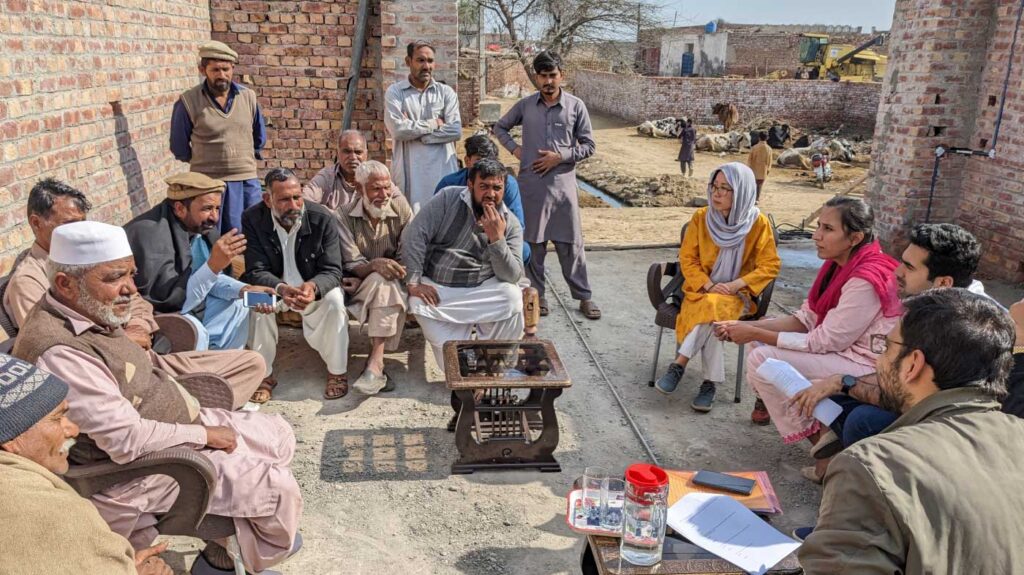
This week much of our attention has been on smallholder rice production. The staple food in Pakistan is of course wheat (for roti), but rice is a major crop for both domestic consumption and export. (We were in town at the same time as the IMF delegation, negotiating a package of macroeconomic reforms to stabilise the economy, so those export earnings are important right now).
Punjab is famous for its basmati rice, a variety much prized for its aroma, fluffiness and grain length. It is very popular in traditional dishes like biryani and pulau. We visited Kala Shah Kaku Rice Research Institute, established in 1926, where basmati rice varieties have been developed since the 1930s. Farmers in Pakistan typically grow wheat in the Rabi season and then many grow rice in the Kharif season, especially in the basmati belt in Punjab. The yield of basmati rice is around half as much per hectare as hybrid rice varieties, but it sells for around twice the price, so generating similar revenues and broadly similar net income per hectare. (An exciting development on the horizon is the prospect of hybrid basmati rice that may have a much higher yield while retaining much of the quality for which basmati rice is famous.)
Many of the people we met were keen to stress that Pakistan, rather than India, is the home of basmati rice. I’d be very glad if the rivalry between these two great nations were confined to arguing about the origin of basmati rice and, far more importantly, their relative prowess in cricket.
Pakistan’s farmers produce on average around 4 tonnes of rice per hectare, about the same as in India. In China, the yield is 7 tonnes per hectare and in Australia 10 tonnes per hectare. The yield gap (that is, the gap between what farmers produce and what they could produce with the land and other inputs available to them) is estimated to be about 50% – about 3.5 tonnes per hectare – for basmati rice, and closer to 60% – 6 tonnes per hectare – for the higher yield but lower price varieties. In other words, farmers could, in principle, at least double their yields. So what is holding them back?
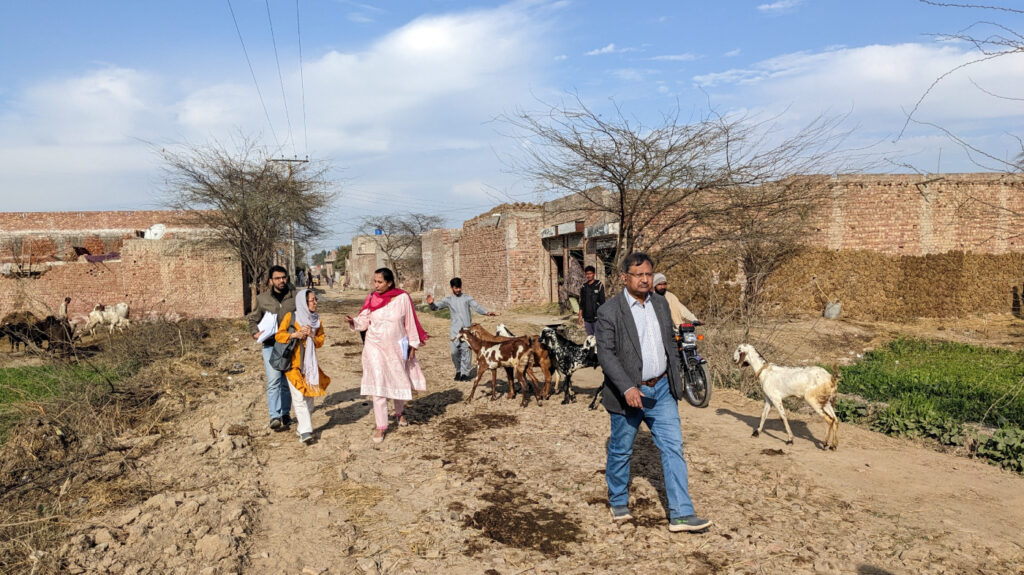
You would expect farmers to be more interested in increasing their profit than their yield, so one possible explanation – in theory – could be that the additional inputs are too costly, and the value of the extra output does not justify the investment. In that case, it would be rational for farmers not to increase their output this way. But that doesn’t seem to be the problem. The additional cost of the recommended inputs, at market prices, is small relative to the price that basmati farmers could get for the roughly extra 3-4 tonnes per hectare that they could be producing. Despite extra input costs, the extra yield on this scale would lead to much higher profits – perhaps multiples of profits now being earned. If you are doing only a little better than breaking even, then moving to a reasonable surplus could mean a transformational increase in net income.
So what is getting in the way? We spent two days in villages outside Lahore talking to farmers, extension agents, and private and public sector experts to try to get a better picture.
My main take-away is that it seems that expensive credit for agricultural inputs and low prices paid by middlemen (called aahrtis) leaves farmers with little surplus. Farmers are unwilling to take on a large, expensive debt which – if the harvest is bad – they may not be able to repay, especially when they know that a big chunk of any profit, if the harvest is good, will go to the middleman. So they stick to limited use of inputs, which gives them lower yields and less debt and thus lower risk. Thus it is the cost of credit, and the associated risk, rather than the cost of the inputs themselves, that stops them from investing more.
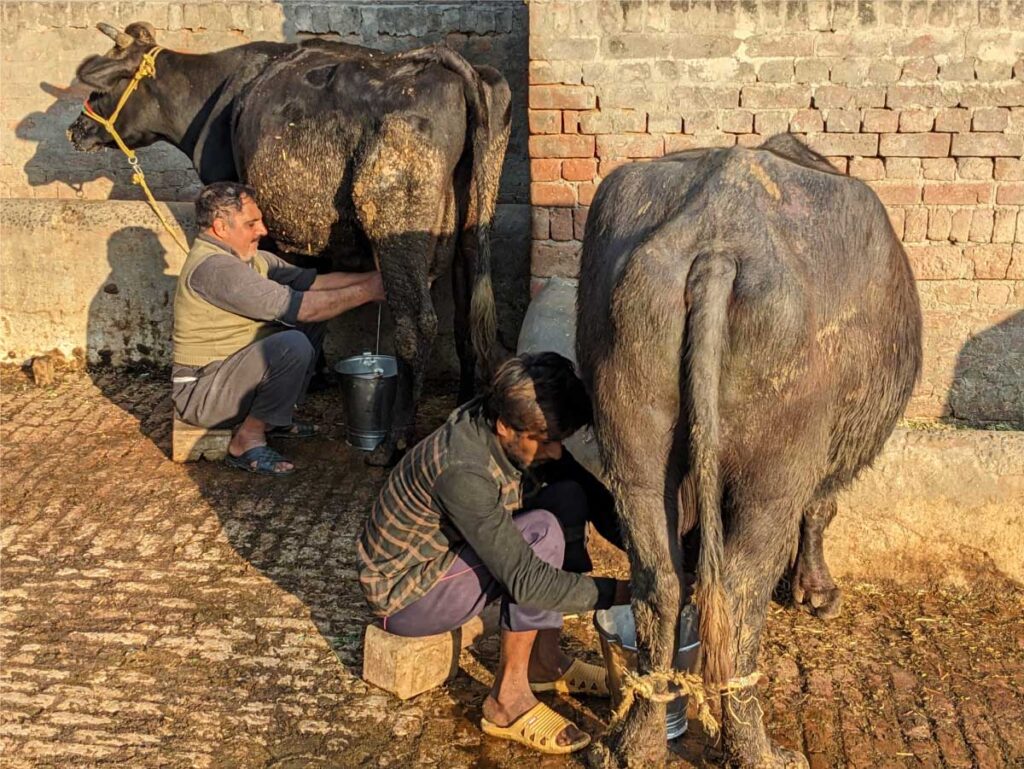
I’m conscious that we met farmers close to Lahore, who are relatively well-off, and who are already in contact with extension services. So we should be careful about drawing too many conclusions. Based on these few conversations with an atypical group of farmers, I find it hard to convince myself that there are very many practices that farmers could adopt that they do not already know about. That said, there may be some value to encouraging practices that cost the farmer little or nothing to implement – or which save inputs such as using the right amount of urea – for example by issuing timely reminders. But it looks as if the larger gains would come if we could find a way to reduce the risk of increased investment in inputs, reduce the cost of credit, provide high-resolution weather information, or perhaps improve planning and coordination in the use of scarce machinery or casual labour.
It is harder to notice what is missing than what is in front of you. As you may see from the photos, we did not meet any women farmers. We met a female scientist at the rice institute, but everyone else we spoke to was a man. In every conversation, farmers were routinely and unthinkingly referred to as “he”. Yet we know that women provide a substantial part of labour in agriculture, and are hugely affected by all the decisions that are made. If we want to understand what it would take for farmers to adopt practices that would increase their yield and their incomes, we are likely to learn a lot by talking to women too.
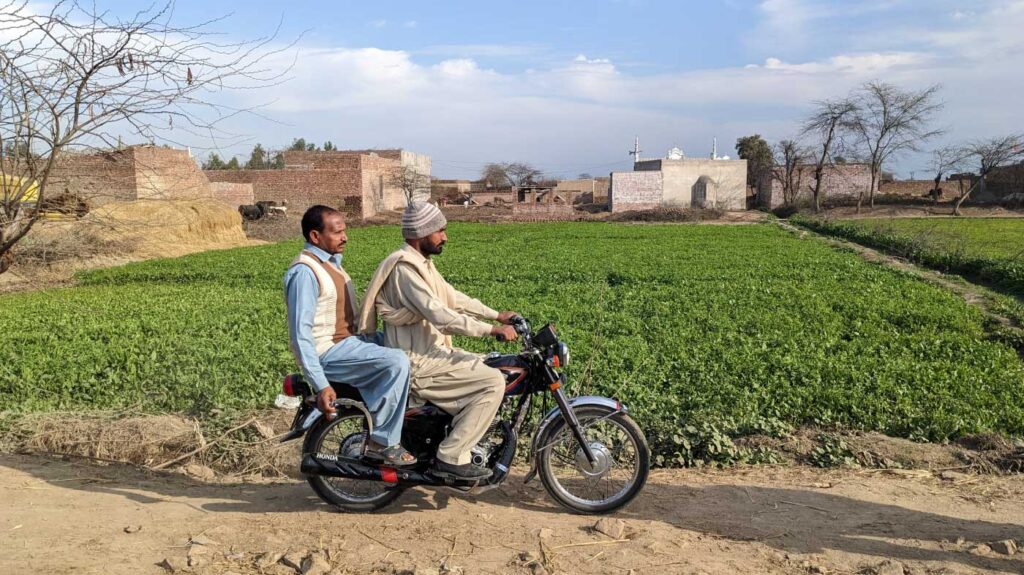
I leave Pakistan optimistic but uncertain. Optimistic because the opportunities are huge for large increases in yield and potentially transformative increases in farmer incomes. The constraints are real, but there may be solutions that have a low marginal cost per farmer and so would be hugely cost-effective at scale. Uncertain because we do not yet have enough information to arrive at robust ideas for higher-impact services that we could design and test.
I want to thank Adeel, and all the team, for giving up so much of their time and energy to host us – including taking us to the old Walled City of Lahore to have dinner overlooking the famous Badshahi Mosque (Mosque of Kings) and the Lahore Fort (Shahi Qila in Urdu), an ancient citadel of the Mughal Empire. I look forward to returning to Pakistan soon and hope to combine my next trip with some tourism in your beautiful country.

PxD is collaborating with the Institute for Governance and Sustainable Development (IGSD) to identify opportunities to benefit poor farming communities through their participation in climate mitigation activities.

The 27th Conference of the Parties (COP 27) to the United Nations Framework Convention on Climate Change, is currently taking place in Sharm El-Sheikh, Egypt. COP27 has been dubbed the “African COP” due to its location as well as its strong focus on food systems and agriculture, both of which present pressing climate-related challenges for the continent and many other Global South geographies.
The adoption of improved inputs, new technologies, and practices enabled the agriculture sector to build many ladders for smallholder farmers to climb out of poverty, particularly following the Green Revolution. As yields have increased and farmers produce more than their families consume, selling surplus production has progressively increased farming families’ incomes, reduced the incidence of famine, and improved global food security.
Yet, from drought in the Horn of Africa to the 100-year flood in Pakistan, climate change is devastating smallholder livelihoods. Among its many pernicious effects, a warming climate will accelerate desertification and the incidence of drought, expose farming families and their animals to extended and escalated levels of heat stress, increase the incidence of catastrophic weather events, further erode the viability of marginal land worked by poor farmers, and contribute to the migration of new pests and disease, as well as the intensification of existing sources of blight and infestation in smallholders’ fields.
The impacts of climate change on agriculture are complicated by the fact that the agricultural sector is a significant emitter of Greenhouse Gases (GHGs), particularly methane – associated with livestock and rice production – and nitrous oxide – associated with nitrogen-rich fertilizers and animal waste. Recent estimates suggest that food production accounts for approximately one-third of global GHG emissions associated with human activities.
The effects of climate change, and agriculture’s role in generating GHG emissions, will undermine agriculture’s historic role as a critical engine for economic growth and lifting people from poverty. It is critical that we develop innovative solutions to combat climate change while assisting those who bear disproportionate effects. Marginal livelihoods will need to be further supported to adapt to a changing climate to mitigate the risk of deepening poverty. Concurrently, it is critical that we identify opportunities for poor farmers in low- and middle-income countries to contribute to emissions reduction to secure and advance their livelihoods.
In partnership with the Institute for Governance and Sustainable Development (IGSD), Precision Development is investigating opportunities that equip smallholders as agents of climate change mitigation and direct tangible returns, whether through payments for their environmental services or private agronomic benefits, to participating smallholder communities.
This work is guided by the following principles:
- Farmer benefit first: Smallholder farmers can not be expected to pay the price for climate mitigation. Climate-related advisory should support livelihoods and if it is difficult to understand a priori how a specific agricultural practice or technology might impact yields or income, we commit to exploring ways to compensate early adopters as payment for the broader social benefit.
- Consider the cost-benefit ratio: We aim to determine smallholders farmers’ private returns to the adoption of new technologies or agricultural practices, as well as the societal return of such adoption, as measured through the impact of these innovations on our main outcomes of interest in the climate mitigation space (i.e., GHG emissions).
- Replicate and Scale: We aim to deliver impact at scale. We are particularly interested in feasible low-cost innovations with a high potential for impact at scale that can be customized to local contexts.
The results of our investigations will be published as several analytical reports in the coming months. In advance of those publications, this post collates an overview of our findings about practices that are most likely to meet these criteria.
Carbon Dioxide Mitigation through Enhanced Rock Weathering (ERW)
Enhanced rock weathering is a new technology to draw down carbon that leverages the natural weathering process of certain types of rocks. Finely ground rocks are applied to soils to drive chemical reactions which capture atmospheric carbon and convert it into stable forms. This stable carbon then flows through groundwater into the oceans, where it can be stored for thousands of years. The application of ERW has significant potential for scale, and permanent carbon drawdown, particularly on agricultural land. However, the implementation of ERW technologies has been limited largely to study environments in high-income countries. Even in these contexts, market, scientific, and technical mechanisms for its successful deployment require further development (i.e. carbon crediting methodology). There is significant interest from climate financing organizations. For example, Frontier – an entity with significant backing from the tech industry – is pursuing an advanced market commitment to fund carbon removal through ERW. However, given the current focus of ERW development in Global North geographies in the absence of a concerted parallel effort in the Global South, it is likely that any future economic benefits accruing to farmers from ERW in the form of carbon offset payments will disproportionately benefit farmers in rich countries. Our research aims to shift some of these actions and benefits to include poor smallholder farmers in low- and middle-income countries.
Carbon Mitigation through Organic Carbon Strategies (e.g. Soil Organic Carbon (SOC) sequestration)
There is evidence that conservation agriculture practices – such as reduced tillage, the use of cover crops, and intercropping – promote the sequestration of carbon in soils. However, the outcomes of SOC sequestration as a mitigation strategy and the exact amount of carbon stored by different types of soil and under different climatic conditions are still being investigated. For example, because the carbon and nitrogen cycles of soils are closely intertwined, increasing SOC requires sufficient nitrogen. However, increasing nitrogen in soils can create conditions for the leakage of nitrous oxide, which could offset SOC gains.
Conservation agriculture practices such as SOC sequestration do not facilitate permanent carbon drawdown and must be implemented continuously to sustain carbon sequestration, an important consideration when assessing SOC’s potential for persistently increasing carbon drawdown over time. Due to these constraints, there is a growing scientific consensus to emphasize the soil health benefits (i.e. bulk density, improved water retention, etc) and farmer outcomes (i.e. yields, profits) associated with these conservation agricultural practices, rather than solely their carbon sequestration potential. The productivity gains associated with improved soil health can be significant, especially for balancing climate change mitigation goals with global food security needs.
Another potential benefit of SOC sequestration interventions is the connection to nature-based carbon credit projects which can provide smallholder farmers with payment for their mitigation efforts. However, while many SOC-sequestration-based voluntary credit market projects exist (for example, Indigo Ag), the absence of standardized measurement, reporting, and verification (MRV) protocols for climate outcomes (like the amount of carbon stored), remains a challenge. This absence of MRV protocols makes it difficult to compare and evaluate the efficacy of SOC-based mitigation interventions, and – as a consequence – complicates efforts to create high-quality credits with higher prices for optimal farmer payout. Moreover, accurately measuring SOC sequestration is likely to require soil sampling, an expensive enterprise with negative implications for the cost-effectiveness of SOC sequestration projects. Concurrently, prices for nature-based projects in voluntary carbon market regimes are low and volatile which may limit the effectiveness of payouts to farmers.
Ensuring that organic carbon strategies, such as SOC sequestration, meaningfully contribute to mitigation, will require coordination and mutual investment in MRV protocols and pathways and careful consideration of the ways in which carbon mitigation projects impact small farmers’ bottom lines.
Nitrous Oxide Mitigation through Precision Nutrient Management
Emissions of nitrous oxide from human activities are primarily driven by inefficient nitrogen fertilizer use in agriculture, particularly overuse. One mitigation strategy with proven potential for reducing nitrous oxide emissions as well as improving farmer outcomes is Site Specific Nutrient Management (SSNM), mainly through decision-support tools like Leaf Color Charts (LCCs). These tools enable farmers to make more informed decisions about the management of nitrogen fertilizer applications based on site-specific needs and their own environment, reducing the overuse or underuse of N-based fertilizers. There are notable considerations to address in scaling and operationalizing these tools, including their calibration across value chains and agroecological conditions, instruments distribution channels, and user experience. PxD gained first-hand experience deploying LCCs on the ground during the implementation of a pilot project to test their effectiveness in Gujarat, India. We are working to find innovative solutions, such as creating a digital LCC, that can reach farmers at scale. Further experimentation and farmer-led innovation will help to address these challenges and increase the use, and subsequent impact, of SSNM decision support tools which have proven potential for nitrous oxide emissions reduction.
Methane Mitigation in Dairy through Improved Livestock Feeding Practices
Milk yields in low- and middle-income countries are significantly lower than their potential, resulting in high methane emissions per liter of milk. A key mitigation strategy to curb methane emissions in livestock farming, particularly for large ruminants like dairy cows, is to improve feeding practices that increase milk production per cow and lower the methane intensity of production. Coupled with a decrease in herd sizes, an increase in milk productivity can decrease net methane emissions in the dairy sector and relieve the overall land pressure of livestock, which can further mitigate GHG emissions. Studies examining the mitigation potential of various livestock interventions underscore the significant potential of improved feeding and digestibility compared to other strategies like manure management, rangeland rehabilitation, and the use of feed additives. For example, in India, the world’s largest producer of milk, improving livestock feeds for local cattle breeds can double current milk yields. Findings from PxD research with smallholder farmers in Kenya suggest that there are significant knowledge gaps about ways to improve livestock feeds, including available methods, some of which are already implemented by peers (i.e. feeding cows sweet potato vines, napier grass, etc). Coupling the optimization of feeds for dairy cows with a parallel effort on market development will not only provide farmers with the tools to intensify production, and thereby mitigate methane emissions, but also generate incentives to do so.
Future Work on Climate Mitigation at PxD
Poor smallholder farmers should have the same opportunities as farmers in high-income countries to be rewarded for contributing to climate change mitigation. PxD is working to identify high-impact opportunities for climate change mitigation that leverage local knowledge in low- and middle-income countries as well as our expertise to combine at-scale product development, behavioral science, and human-centered design with robust experimentation. We are particularly interested in exploring climate financing mechanisms and MRV protocols that bridge the environmental efforts of smallholder farmers and global climate finance.
In the past year, systems built and developed by PxD serviced over seven million farmers in nine geographies. We aim to leverage our scale to generate sizable impacts to reduce GHG emissions associated with smallholder economies. As we do so, we aim to benefit farmers working in the service of mitigation, be it in the form of private returns or payments for environmental services. In pursuing these goals we will need to partner with nonprofits and research institutions to develop robust mitigation programs. We welcome connections with organizations and funders who believe – like we do – that there are opportunities for smallholder farmers to actively mitigate climate change, and that by activating these opportunities, we can add new agrarian ladders out of poverty to those that have come in decades and centuries past.
**this text was amended to include new information on 22 November 2022
When disease and a heatwave, followed by devastating floods ravaged Pakistan’s Punjab province, PxD’s LMAFRP digital information service, which we implement in partnership with the Rural Community Development Society (RCDS) with support from the International Fund for Agricultural Development (IFAD), assisted women livestock farmers navigate new and unprecedented challenges. This International Day of Rural Women, we highlight the important role women play in Punjab’s rural farming economy and our work to promote information to enhance more productive and resilient livelihoods.
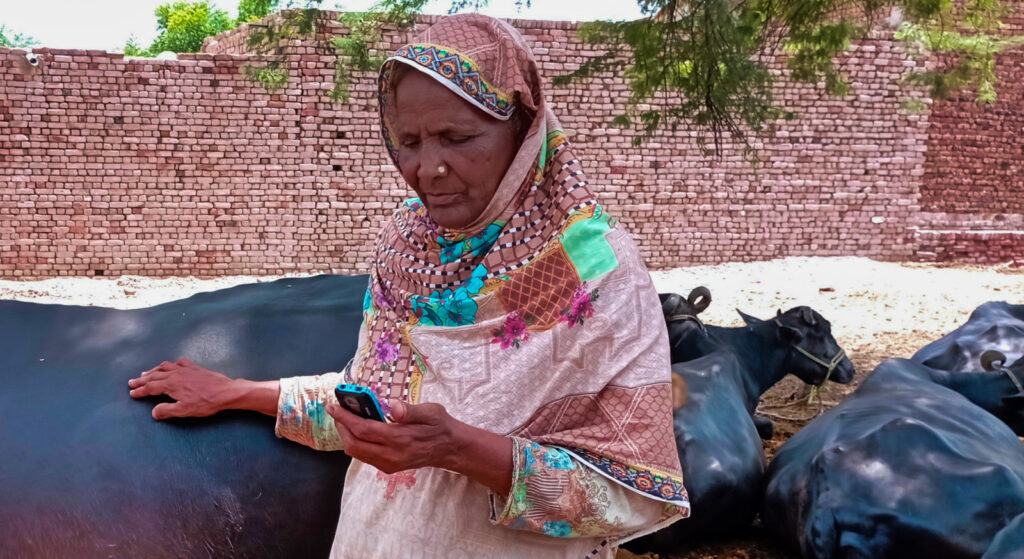
Introduction
Livestock husbandry and livestock-related products (dairy, meat, leather goods, etc.) constitute an important sub-sector of Pakistan’s agriculture sector: Pakistan is the fourth largest milk-producing country in the world1Sattar, Abdul, “Milk Production in Pakistan” PIDE Blog, pide.org.pk/blog/milk-production-in-pakistan , and the share of livestock products in the generation of foreign exchange is approximately 13%2Government of the Punjab, “Livestock Contribution” , livestock.punjab.gov.pk/livestock-contribution. As is the case in many smallholder economies, in Pakistan, women are largely responsible for the care of livestock and for the production of many livestock-related products, particularly dairy3Ibid..
In rural areas, livestock plays an outsize role in livelihoods, with the Punjab provincial government estimating that “livestock is an integral part (30-40%) of the livelihood of about 30 to 35 million rural farmers”4Ibid.. Livestock-related products, such as butter, eggs, meat, and animal fats (oils), contribute important nutrients for all households – rural and urban – and play a critical role in meeting the nutritional needs of rural children. Further, livestock contribute an important source of continuous income which can sustain poor rural households between seasonal crop-related revenues, and insulate them from shocks5Ahmad, Tusawar Iftikhar and Tanwir, Farooq, “Factors Affecting Women’s Participation in Livestock Management Activities: A Case of Punjab-Pakistan”, mpra.ub.uni-muenchen.de/93312/1/MPRA_paper_93312.pdf..
For these reasons and more, supporting the development and improvement of livestock farming can have a considerable impact on improving the livelihoods of Pakistan’s rural population, and can impact the livelihoods and status of rural women. We believe significant gains can accrue to rural farming families through the promotion of best practices to women. Improved practices can improve yields and minimize losses, leading to increases in income from livestock farming.
Many rural women are unaware of best practices that can optimize outputs associated with livestock, and access to information and economic opportunities can be constrained by cultural and geographic barriers. As documented elsewhere on this blog, digital extension services offer cost-effective and easily scalable solutions with very low marginal costs. In rural Pakistan, where many women rarely leave their homesteads, the portability of digital information offers additional advantages for navigating geographically and culturally hard-to-reach spaces.
Geographic and cultural constraints to attending in-person RCDS livestock training sessions were exacerbated by social distancing introduced to mitigate the COVID-19 pandemic. RCDS’s in-person activities were suspended in the initial months of the pandemic, but the utility of advisory information increased as rural households navigated new challenges in a time of escalated economic stress. It was at this time that RCDS and PxD initiated a partnership to deliver advice to livestock-rearing women in rural regions of Punjab province in Pakistan. This collaboration, supported by IFAD, provides customized and actionable digital information to livestock-rearing women. Combining PxD’s experience in delivering digital extension services to Punjabi farmers and RCDS’s extensive local knowledge and expertise, the service draws on demographic insights, and cultural practices to deliver information that is accessible, comprehensible, and actionable for recipients.
The resultant digital advisory service has proven to be an effective, cost-efficient, and scalable supplement to in-person training, and is now extended in the absence of COVID-19-related social-distancing constraints. The service demonstrated new advantages when unfamiliar disease- and climate-related threats subsequently impacted rural households.
The Service
RCDS’s experience and local trust in their services have been integral to the success of the initiative. Over the past two decades, RCDS has partnered with local, federal, and international institutions to build a significant rural network to promote and implement development programs to assist poverty-stricken segments of society in rural areas of Pakistan.
Advisory content was developed in partnership with local livestock consultants who were well-informed about local livestock issues and output-increasing best practices. The advisory information distributed by the service covers a wide array of topics, including disease identification, information about and access to vaccinations, disease prevention and remedies, practices to increase milk yields, and guidance on protecting livestock against climate-related shocks.
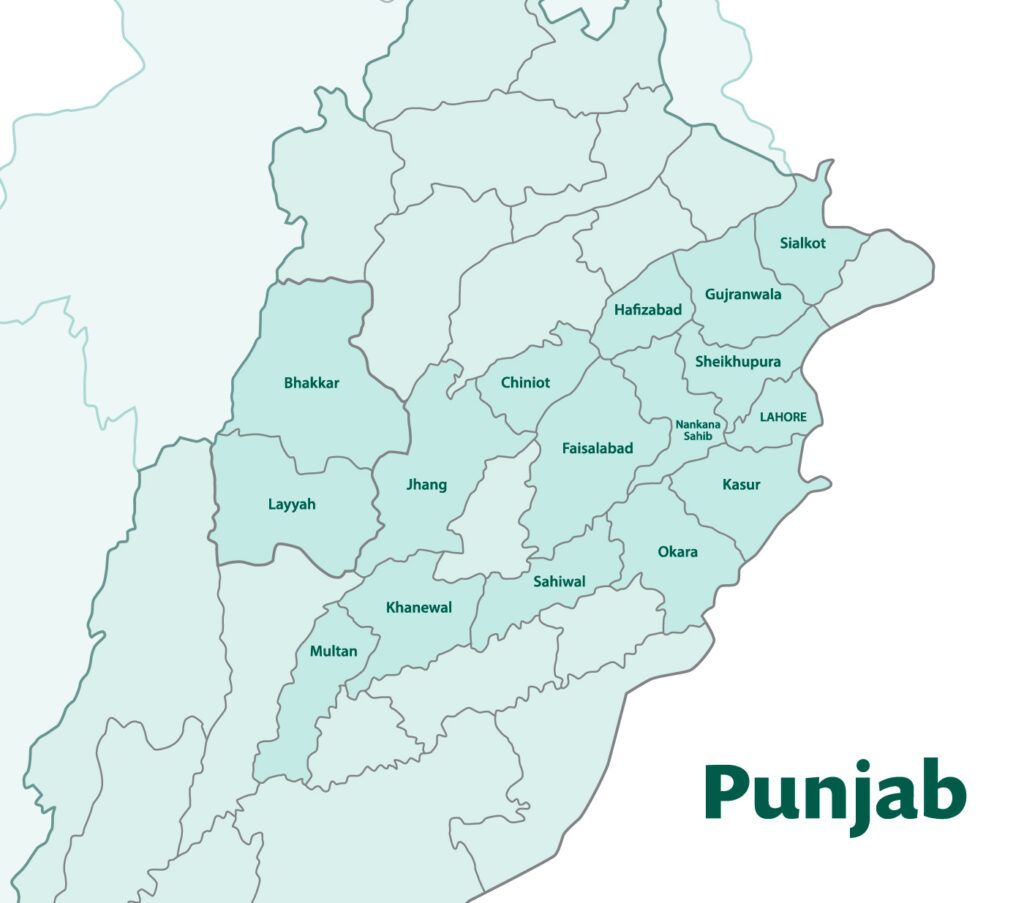
After conducting a baseline survey to systematically understand the informational needs of women farmers in four districts in Punjab, and the development of advisory information, PxD piloted digital services among 3,160 rural women associated with RCDS. The four districts, in which the pilot was concentrated, are among the poorest districts of Punjab, all of which are located in the south of the province. Given the success of the initial pilot, the service has subsequently been expanded to more than 50,000 livestock-rearing women in 16 rural districts of Punjab.
One of the key components that PxD assessed during the initiative was the extent of knowledge retention by participating women after they received the advisory. Pilot testing in the early stages showed that the advisory information was not only useful but was also retained for a significant period after it was delivered.
RCDS maintains a dataset of women who have either attended in-person sessions of livestock advisory or shown an interest in livestock advisory or have taken a microfinance loan for livestock farming. This data, and its quality, were instrumental in helping PxD deliver the advisory directly to the women via their phones. Furthermore, the data also contained the districts in which each woman resided. This was used to help decide in which of the two local languages – Punjabi and Saraiki – the advisory would be conveyed.
Advisory information is delivered through a voice call. A text message is sent 24 hours before the call to alert users that they should expect a call the next day. This is done to ensure that the advisory is received by women. A barrier highlighted by the baseline survey was limited access to mobile phones on the part of women in the region. Cultural and financial constraints make it far more likely that men have primary access to cell phones. Hence, the time allotted for the voice calls is set at a specific hour in the evening, so that the call is received in the evening when the family is no longer busy with agricultural activities, men are more likely to be home, and when family members can collectively listen to the advisory in their homes.
The voice call has local cultural music layered in the background, to assist the participant in developing trust in and comfort with the message. The information is delivered in the local dialect – Punjabi or Saraiki – to enhance understanding of and familiarity with the recorded message. Further, listeners are told that the advisory is from RCDS since it is well-known as a trusted organization in these regions. As a general protocol, to improve pick-up rates when the voice call is unanswered, another call is placed after a 15 to 30-minute interval.
Lumpy Skin Disease
A significant advantage of digital extension is the ability to send timeous information. This is particularly valuable to address and prevent viral diseases that can have a drastically negative impact on the well-being of the livestock.
In April 2022, Pakistan saw a viral outbreak of lumpy skin disease in cattle. The disease was transmitted between cattle via blood-feeding insects. The disease has a high virulence and fatality rate and killed thousands of cattle in the country.
A significant hurdle that seriously hindered timely prevention and actions to curtail the impacts of the infestation was the lack of baseline knowledge and awareness of the disease. Moreover, misinformation was rife, with misplaced rumors about negative effects of vaccines abounding. Many people mistakenly believed that it was the vaccines that were causing deaths among animals, when animals that had died were either already infected with lumpy skin disease, or were generally sick and should not have been vaccinated at the time.
Understanding these knowledge gaps, PxD and RCDS collaborated to provide timely information about the infestation. Initial infections were observed in the southern part of the country and slowly spread north towards Punjab province, where our users reside. PxD started providing information about lumpy skin before the disease had become widespread in the province.
Our farmer-users were given information about the disease and its virulence, how it is spread, and traditional preventative measures. Following that, to increase the survival rate of infected cattle, users of the service were advised to vaccinate their cattle as soon as vaccines became available. Participants were also informed about how to identify early signs of the disease on the animal.
Anecdotal feedback received by RCDS in the field suggests that the messages were very useful. Users with whom PxD surveyed reported that in many instances they were able to avoid fatal infections in their animals due to timely vaccines, even if their animals did get infected.

The Floods
In the summer of 2022, Pakistan witnessed firsthand the severe impacts of climate change. In March and April, the country experienced a crippling heat wave, followed by a record-breaking monsoon season in Punjab, Sindh, and Balochistan spanning June, July, and August. An unparalleled monsoon, coupled with unprecedented melting of glaciers in the north due to the initial heatwave, led to extreme flooding in rivers that flow from the north of Pakistan to the south. The floods are estimated to have impacted at least one-third of Pakistan, including the livelihoods of 33 million people.
Prior to the floods, the extreme heat waves had contributed to a general belief that floods were imminent. To counter the threat, the PxD team in Pakistan worked with RCDS to preemptively identify areas prone to flooding, and prepare advisory messages with useful information about managing floods, and adaptive strategies to protect assets and livelihoods.
A major problem with livestock is their slow mobilization, making them and their rearers prone to becoming flood victims. Timely warnings and regular updates via voice call advisory messages provided participants with information for ensuring the safety of their livestock during the floods. PxD and RCDS made use of their existing program to deliver instructions, warnings, measures, and assistance via voice call messages, to inform participating women and their families about floods and ways to protect themselves and their livestock.
Meeting today’s challenges
The advisory service designed by PxD, and delivered in partnership with RCDS, provided an effective method to deliver timely information to livestock farmers. Due to its effectiveness in the regions where it was being delivered, the advisory service was extended to address other unforeseen challenges, such as the virulent lumpy skin disease, and flooding.
In addition, our project has demonstrated the core strengths of digital communication: it is cost-effective, scalable, and capable of reaching regions and communities that are disconnected or hard to access due to difficult terrain, long distances, or cultural constraints.
Our advisory content was designed to deliver information in a manner that does not require the recipient to have prior knowledge, or education to understand the subject. The use of familiar dialects and carefully crafted messages made the information accessible, easy to understand, and ultimately very effective.
PxD aims to further extend the benefits of digital communication to support other low-cost interventions among rural communities of Pakistan. More specifically, feedback received from users has prompted PxD to further our partnership with RCDS to envisage interventions to support digital veterinary services. We are motivated to continue to harness the power of digital communication to facilitate more productive and resilient livelihoods in rural communities of Pakistan.
From confronting cataclysmic floods in Pakistan, to biblical pest infestations in east Africa, smallholder farmers are on the frontline of an escalating climate crisis. Poor farmers, whose livelihoods disproportionately depend on rainfed agriculture, are particularly vulnerable. The destabilizing impacts of a changing climate will drive many millions of farming families deeper into poverty.
At PxD, we work with millions of farmers to give them the information they need to make more informed decisions about unfamiliar and escalating challenges. We are honored that our MoA-INFO service in Kenya was chosen by the Global Center for Adaptation (GCA) as a case study to highlight the utility of digital information for assisting smallholder farmers as they struggle to adapt to climate change.
In the video below, funded and produced by GCA, Kuboka Maureen, a member of our agronomic team based in Kakamega, is joined by MoA-INFO farmers to explain how the service has assisted Kenyan farmers to navigate climate-related threats.
In consortium with Rare and The Nature Conservancy (TNC), PxD received a one-year grant from UK PACT in December 2020 to support the implementation of a project to promote sustainable and productive agriculture through behavioral change. PxD’s Colombia team – activated remotely under pandemic conditions – implemented the project over twelve months, sending climate-smart agricultural advice to smallholder farmers in Colombia’s Meta region. The main focus of the advice was to provide farmers with “win-win” recommendations to concurrently increase crop productivity and reduce environmentally harmful farming practices. The project was PxD’s first in the Americas and was unique in a number of respects – including a high penetration of smartphones among the user base, and an environment and digital culture profoundly shaped by a legacy of conflict.
What was the program about?
PxD, Rare, and TNC partnered to provide a mixed digital and in-person agricultural extension service called “New technologies, mentalities, and practices to transform Colombia’s agricultural sector.” PxD implemented an all-digital component of the project named “Un Mensaje por el Campo” (A message for the field), a two-way SMS service intended to increase crop productivity through the implementation of climate-smart practices for 2,800 farmers. PxD and Rare jointly designed and iterated 37 weeks of content timed to the production cycle of three crops – plantain, cocoa, and coffee – with a focus on practical knowledge such as composting, pruning, and pest and disease management. In addition to advisory promoting climate-smart production of these three primary crops, we also sent content to support the cultivation of perennial crops (the most common being avocado and citrus). To complement the digital approach, our partner Rare implemented an extension service to promote the adoption of sustainable practices by “innovative producers” (understood to be farmers more inclined to include sustainable practices in their day-to-day routines). Concurrently, TNC conducted a community-based pilot to measure carbon emissions.
Our digital platform featured multiple channels for farmer communications: Farmers received push-SMS recommendations weekly between 5:30 and 6:30 pm on Wednesdays and Fridays. In weeks when we were promoting complex topics, we sent recommendations three times a week. Farmers could also send an SMS with the word “menu” to access a repository of all content shared to that point and pull any information they needed. The menu was updated weekly as new content was pushed to farmers. Users could also send questions to our short-code at any time to be answered by our agronomist.
Farmer profile information received through PxD profiling surveys:
- 40.2% women users
- 66.3% reported owning a smartphone
- 35.5% have access to some form of extension services
- Farmers reported average land holdings of 8 hectares.
- 93.8% reported completing at least primary education
- 67.8% reported owning their land and 21% leased the land they worked. Of the remaining 11% of respondents, 8% worked collectively owned land shared with other farmers, 3% were share-croppers renting a piece of land from a permanent owner.
Armed history of the Meta region in Colombia
Building a new program in a region deeply scarred by conflict was demanding and gratifying. Even after the peace agreements, farmers in conflict-affected areas report very limited access to extension services as a result of reluctance on the part of in-person extension providers to visit farmers in areas perceived to be unsafe. Digital extension services can be particularly relevant in these contexts, as digital services can be deployed and managed remotely and can be customized to a region’s particular needs.
In general, farmers in post-conflict regions report limited trust and interaction with government services, including public extension services, and are often reluctant to interact with organizations they do not know.McNamara, P. & Moore, A. (2017). Building Agricultural Extension Capacity in Post-Conflict Settings. Retrieved from: http://hdl.handle.net/20.500.12010/17029.
To improve the likelihood of success, a key challenge for the teams was to build trust in our service while building a program capable of reducing information asymmetries.
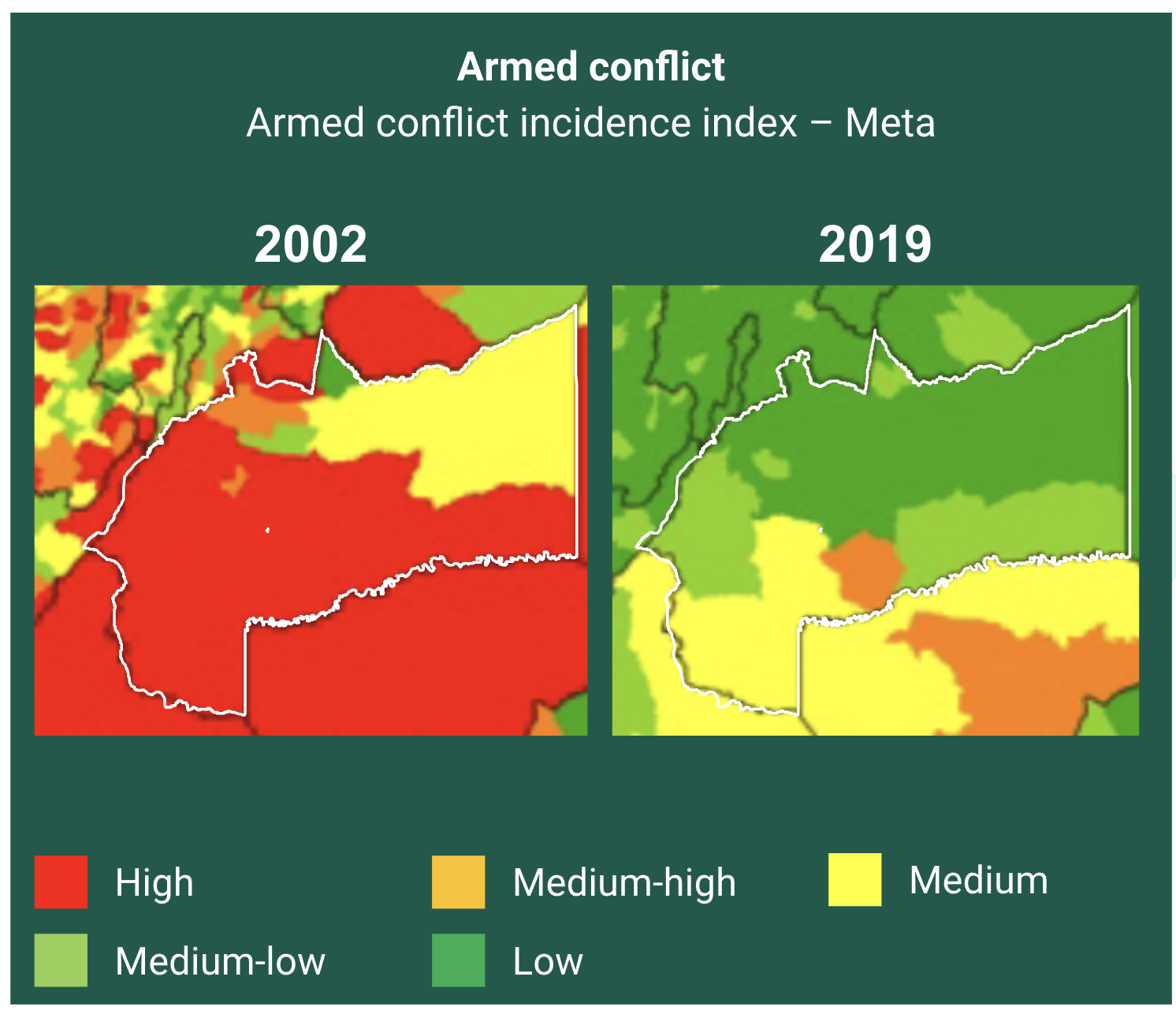
The Meta was the fourth-most conflict-affected region in Colombia in the early 2000s. The map above compares the armed conflict incidence index of 2002 to that of 2019. The index synthesizes six key conflict-related variables: homicides, kidnappings, anti-personnel landmines (number of events), force-displacement, coca crops, and armed actions (from illegal armed groups).
Source: National Planning Department (2021)
How did we measure results from engagement?
Our team used monitoring data to improve our contextual understanding of our user base, to help us identify opportunities for service improvement, and to measure program and intermediate outcomes along a theory of change. As a two-way SMS service, we measured engagement in two ways, which we dubbed “active” and “passive” engagement.
Active engagement was defined as engagement we could measure through PxD’s Paddy platform, the in-house tech platform we used to deploy Un Mensaje por el Campo. Such engagement included accessing the menu (by sending an SMS), replying to content threads, and sending an SMS question to our shortcode. We adopted the “reply 1” feature for most messages to enable users to choose what content they wanted to receive. A generic message such as, “Today we are going to talk about [topic of the day, state the importance of the topic, reply 1 if you want to learn more” invited an initial response. By the end of the program, 23% of users had actively engaged with the service (649 users had actively interacted with the platform at least once as of February 2021). Messages that did not require the “reply 1” feature were usually about topics we considered essential and wanted all farmers to read about. It is thus very likely that a much greater share of farmers read the messages but did not respond. We defined passive engagement as users who reported reading SMS messages via our monitoring surveys. For passive engagement, 56% of our users reported reading our SMS in the polling survey.
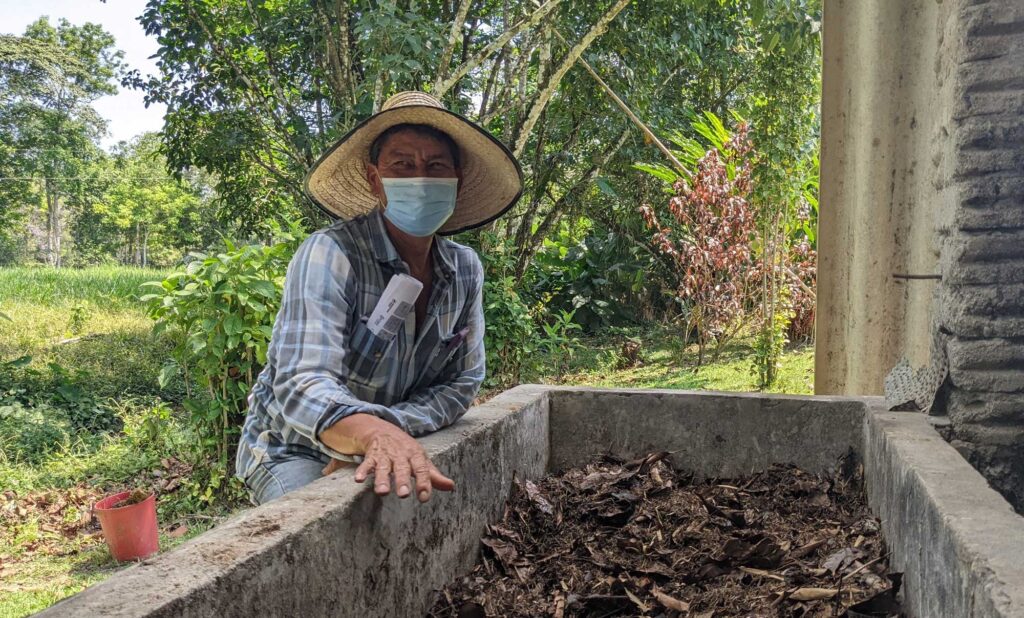
Polling survey findings
We conducted a monitoring and polling survey approximately six months after the commencement of the service. The polling survey aimed to measure practice adoption and service satisfaction. Results for the three primary practices were as follows:
- 36% of respondents reported preparing and applying compost, a practice we emphasized, and 16% (of the 36%) reported doing so for the first time. The soil quality and lack of organic content in the region make composting one of the most economically efficient ways for farmers to replace chemical fertilizers. This is especially relevant in light of significant price increases for agricultural inputs.
- 67% of respondents reported pruning their main crop, and 20% (of the 67%) reported doing so for the first time. Pruning is known to be one of the most effective ways of preventing pests and diseases without using chemical fertilizer.
- 60% of respondents reported applying chemical fertilizer, and 14% (of the 60%) reported doing so for the first time. Given that most farmers use chemical fertilizer, we provided advice on how to use it more efficiently, rather than expecting all farmers to switch exclusively to sustainable practices. Our recommendations focussed specifically on reducing the overuse of chemical fertilizers to minimize environmental degradation and reduce costs.
Respondents were generally enthusiastic about the service. In terms of service satisfaction:
- 75% of respondents reported the content as being relevant to the needs of their crops.
- 88% of respondents said they were likely to recommend our service to neighbors.
- 70% of respondents reported sharing content with their networks, and 59% reported having done so in person. (Great opportunity to explore how farmers not in the service benefited from the information!)
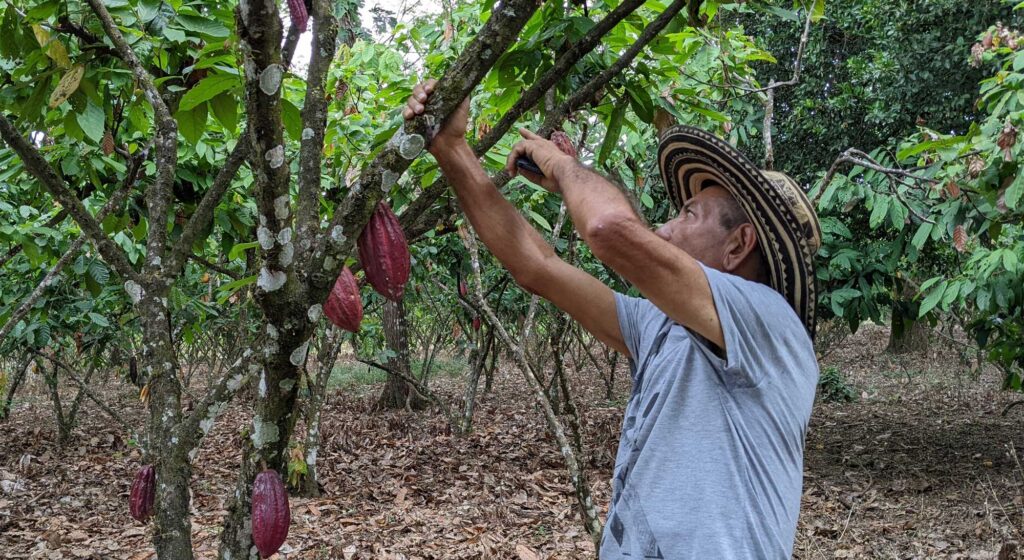
Challenges and learnings
We confronted many challenges over the 12 months of the program. Some had been encountered previously by other PxD teams, and we greatly appreciated their support in navigating the same challenges in a new country. Other difficulties were exclusive to Colombia, and we had to learn to face them with different strategies. We divided our challenges and learnings into content creation, trust-building, and SMS service and network.
Content creation:
To ensure our content was accessible to farmers, we explored ways to time the messages based on evidence from what had worked well in other PxD programs and on Colombian farmer feedback. After a few weeks of sending content, questions such as “How often should we send messages?” and “How often should we repeat content?” started to arise. Following support and advice from other PxD teams, and analyzing evidence from A/B tests, we decided to repeat the most important content at least twice to increase users’ exposure to it. We also implemented “weekly recaps” for which we dedicated a day to highlighting the most important messages of the week.
We also explored opportunities for customization so that farmers could maximize the benefit of our service based on their specific situation. After talking with the Nigeria team, which implements strategies such as creating personas to create the best possible message, taking into account different characteristics, we were able to decide on the best next step. We agreed that after crop segmentation, having customized content based on the agro-ecological zone (rainfall regimes) and based on the users’ technological level would be an appropriate next step. Unfortunately, the project’s implementation horizon did not allow sufficient time to achieve this level of customization.
We were also able to improve efficiency in the content creation process along the way. We worked towards reducing the number of iterations it took to get to a final message, while ensuring that the content remained of a high quality. By the end of the 12-month implementation period, we had settled on the following standardized template to design an SMS: Introduce the topic → Explain why the topic is important → Explain our recommendation → Explain how the activity should be performed.
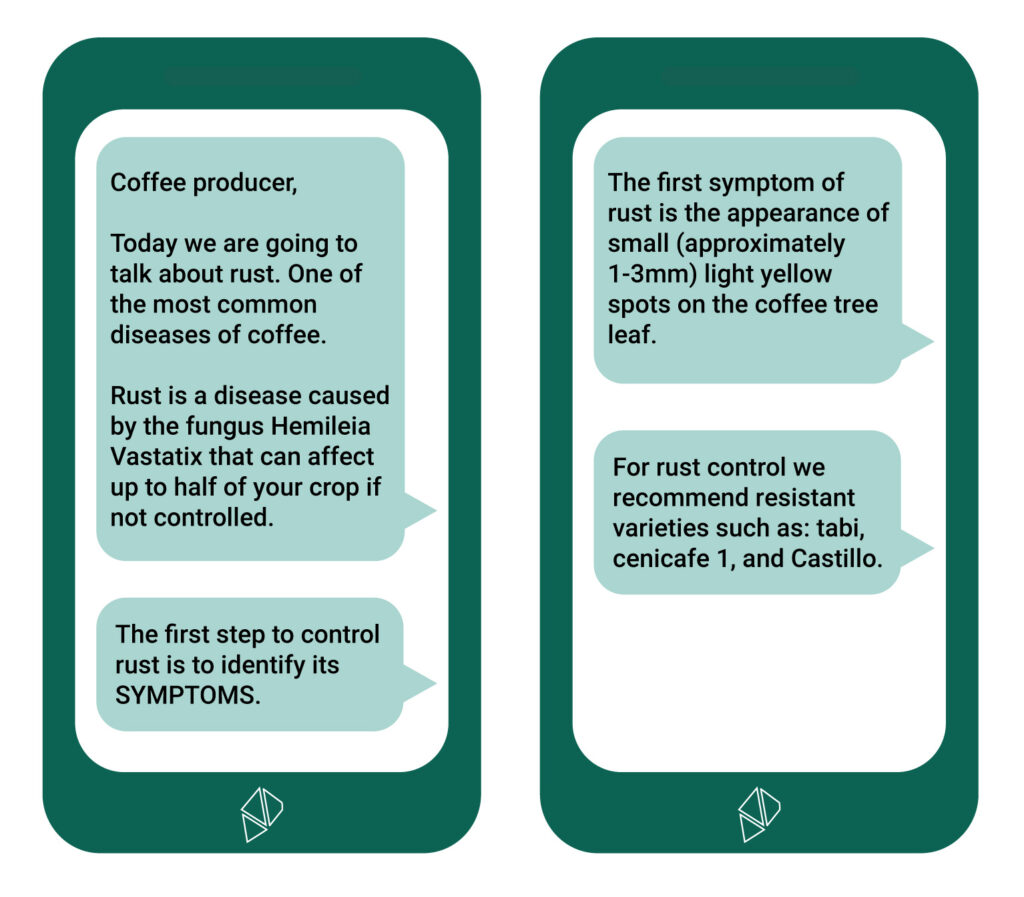
Building trust
One of the most important steps when introducing a digital extension service is creating a relationship with farmers. A strong relationship translates into trust, which increases the potential impact of the service through increased engagement, asking questions, and recommending the service to loved ones. However, previous high exposure to armed conflict made farmers initially reluctant to receive and interact with the service. Moreover, users’ phone numbers were collected by Rare (our on-the-ground partner) and farmer associations, and many users were unaware of their enrollment in the advisory service when they started receiving messages. To improve our relationship with farmers, we implemented four strategies:
- Leverage local networks to build trust in the service. We contacted leaders of farmer associations and mayors of municipalities and asked them to help us spread awareness of the program through monthly meetings with farmers and WhatsApp groups.
- Always send SMSes from the same short code so that farmers become accustomed to it.
- Conduct onboarding calls to all farmers in our database to introduce the program to them and facilitate trust-building, and complement the calls with fieldwork. (We also conducted the onboarding call when new farmers were added to the program.)
- Provide users with an easy name they can think of when talking about the service, e.g. “Un Mensaje por el Campo” (some of our users had our contact saved with this name!)
SMS service and networking:
High variance in connectivity quality among municipalities in Colombia in general and in the Meta region in particular was a significant challenge. Some users only received messages when they went to the municipal center (e.g. on Sundays when farmers traveled to buy groceries). This is both a blessing and a curse, as while farmers did eventually receive the messages, the messages could not be precisely timed, which could hinder trust. Repeating content and leveraging weekly recaps to ensure priority recommendations were getting across to users thus became more critical.
Another characteristic of the Colombia program was that users were unfamiliar with SMSes despite the medium being considered the best option in light of connectivity challenges. The most common problem we faced was that users were not in the habit of checking their SMS inboxes, and some did not even know where their SMS inbox was. To address this particular issue, we did a pilot using WhatsApp to complement the advisory service, sending WhatsApp messages to 1,200 farmers over two months. On average, 76% of users read these messages. This also highlighted how vital ongoing training is to familiarize users with the platform; one-time training is not enough. While we cannot do a perfect comparison with the self-reported reading of SMSes, WhatsApp messages suggest a promising channel for increasing engagement with the service in future programs.
Conclusion
Starting a new program in a new country and on a new continent was challenging but very rewarding. Despite some key team members living outside of Colombia in the initial four months of implementation, we built a strong team during the COVID pandemic and launched a new service that was innovative for PxD in many ways, providing digital extension services through WhatsApp, exploring new ways to build trust in a post-conflict environment, navigating poor connectivity, and prioritizing content in the context of a new country. We learned how to implement a sustainable and impactful program in Colombia and are now working towards new opportunities and partnerships in Colombia and the wider Latin America region. We hope to soon leverage all of our knowledge and experience from this project and continue to grow our presence in this part of the world.
Precision Development (PxD) has completed a landscape analysis to more systematically understand the challenges faced by users of the Coffee Krishi Taranga (CKT) service, with a focus on three core areas, namely, sustainability, market linkages, and gender. This work was funded by a grant from the Walmart Foundation.
As part of the landscape analysis, we conducted multiple rounds of farmer interviews, an extensive review of the literature, an analysis of our existing farmer database, and interviews with sectoral experts. In this blog, we share some key findings and information about what we’re looking to do next.
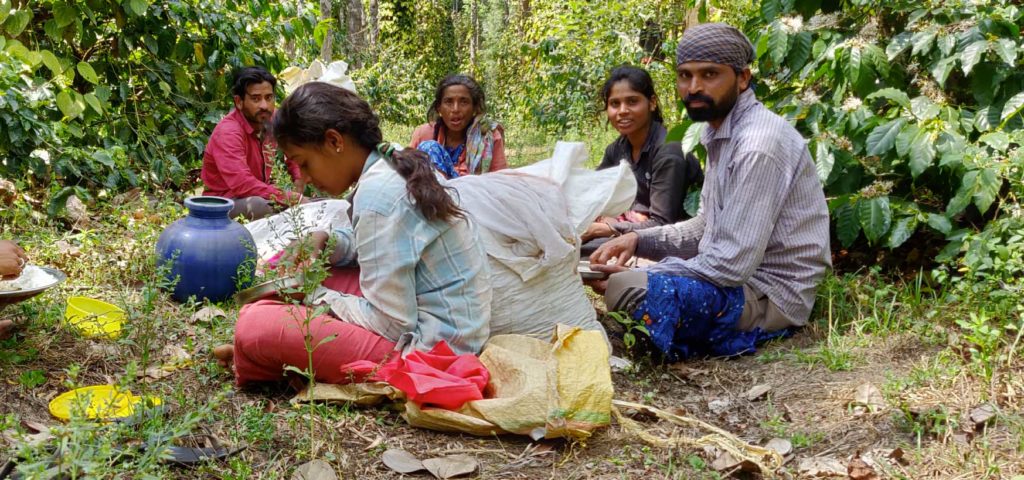
Coffee Krishi Taranga
Since August 2018, PxD has partnered with the Coffee Board of India to provide the CKT service to coffee growers. The CKT service is modeled on PxD’s flagship two-way Interactive Voice Response (IVR) service, which comprises an outgoing service that provides regular advisory to growers on their mobile phones and an inbound hotline that farmers can call to access free information services, including market-related information, and leave messages to be answered by agronomists. As of April 2022, the CKT services approximately 74,000 coffee growers across the states of Karnataka, Tamil Nadu, and Kerala. The team plans to expand the reach of the service to growers in Andhra Pradesh soon.
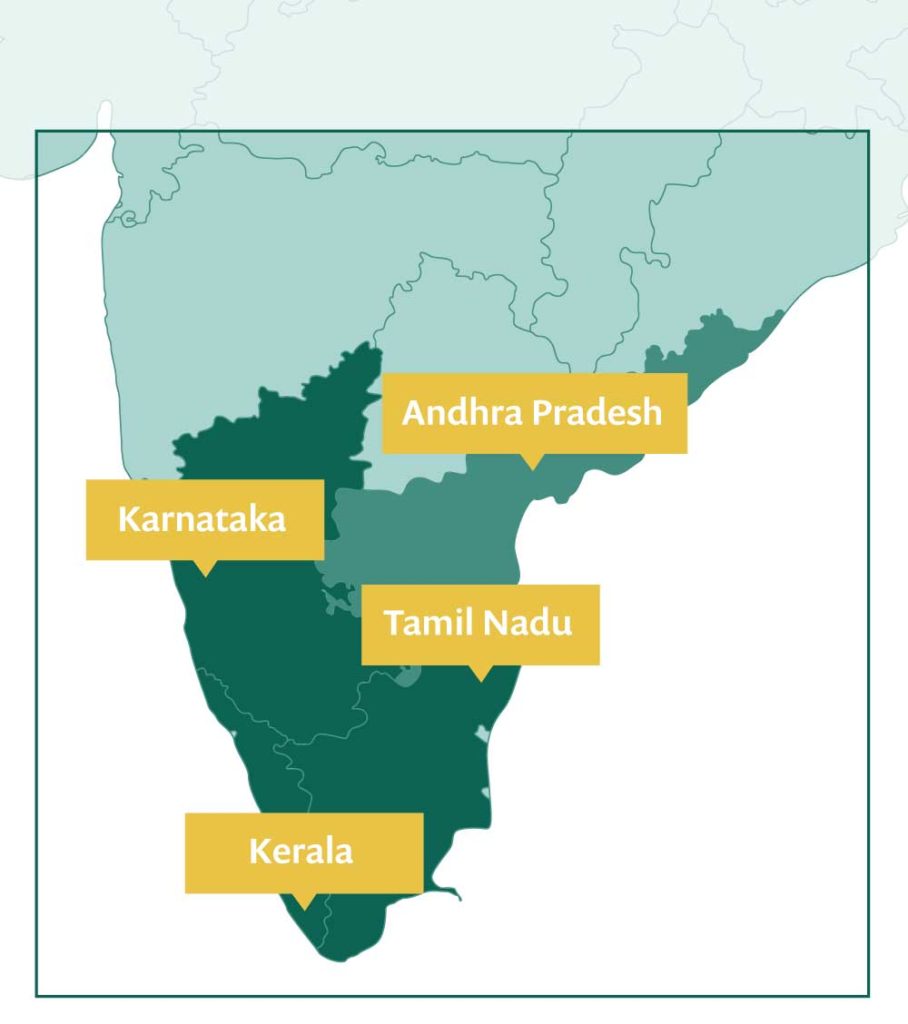
Key findings
Sustainability
Coffee growers in India face multiple risks linked to weather unpredictability, a challenge that has been exacerbated by climate change. Coffee is a sensitive crop, and heat and rainfall are widely considered to be the two most important factors for coffee growth1Haggar, J. and Schepp, K. (2012). Coffee and Climate Change Impacts and options for adaptation in Brazil, Guatemala, Tanzania and Vietnam. National Resources Institute Working Paper Series: Climate Change, Agriculture and Natural Resources, [online] No. 4, pp.1–50. Available at: https://www.nri.org/publications/working-paper-series/4-coffee-and-climate-change/file [Accessed 14 Sep. 2021].. In farmer interviews conducted in September 2021, 92% of farmers (N=83) said they had faced a weather-related challenge in the past year2Haggar, J. and Schepp, K. (2012). Coffee and Climate Change Impacts and options for adaptation in Brazil, Guatemala, Tanzania and Vietnam. National Resources Institute Working Paper Series: Climate Change, Agriculture and Natural Resources, [online] No. 4, pp.1–50. Available at: https://www.nri.org/publications/working-paper-series/4-coffee-and-climate-change/file [Accessed 14 Sep. 2021].. Weather can negatively impact the cultivation of coffee in a variety of ways, including crop damage at sensitive times such as blooming3Pokiya, T. (2021). Interview: Agronomist, PxD. 16 Jun. , increased incidence of pests and disease, increased soil erosion, and more.
What are we doing?
One obvious solution to mitigate the risks of weather variability is weather forecasts, in particular providing customized weather forecasts or real-time weather information, potentially coupled with relevant agronomic recommendations. However, access to high-quality forecasts is limited. In our farmer interviews, only 16% (N=73) said they have access to forecasts4 Krishi Taranga coffee growers (2021). Qualitative farmer surveys: Round 5. 24 Sep.. Our team is currently in the process of putting together a pilot to test the impact of providing customized weather forecasts on key agricultural practices (if you’re interested in learning more about PxD’s weather-related learnings, check out this recent series of blogs).
“The weather imbalance leads to severe black rot and we cannot use spray at the right time.”
Interview with D.S. Sathish, Basrikatte, Chikmagalur
The increase in average temperature and erratic rainfall also exacerbates risks associated with certain pests5 Watts, C. (2016). A Brewing Storm: The climate change risks to coffee. [online] The Climate Institute, pp.1–14. Available at: https://www.juntospelaagua.com.br/wp-content/uploads/2016/09/Pesquisa-sobre-caf—The-Climate-Institute.pdf [Accessed 14 Sep. 2021].. The impact of climate change on pests varies, but overall heavy rain and warmer temperatures are likely to increase the conditions in which several pests thrive. These pests can cause varying levels of damage — some can be devastating, resulting in crop losses of up to 70% if not treated timeously and effectively.6Machenahalli, S., Ranjini, A. P., Madhu S., Giri, Sudha M., Daivasikamani, S. and Surya Prakash Rao N. (2019). Disease of Coffee during monsoon season and their management. [online] Planter’s World, May, pp.4–7. Available at: https://krishi.icar.gov.in/jspui/bitstream/123456789/23682/1/coffee%20disease%20during%20monsoon.pdf [Accessed 14 Sep. 2021].
To explore ways to provide more targeted and actionable recommendations for pest management, we ran an A/B test in November 2021 that looked at the impact of sending multiple reminders on farmers’ knowledge and adoption of high impact practices. We focused on the treatment of white stem borer, an increasingly common pest for coffee growers in India. The results from this test will be shared shortly!
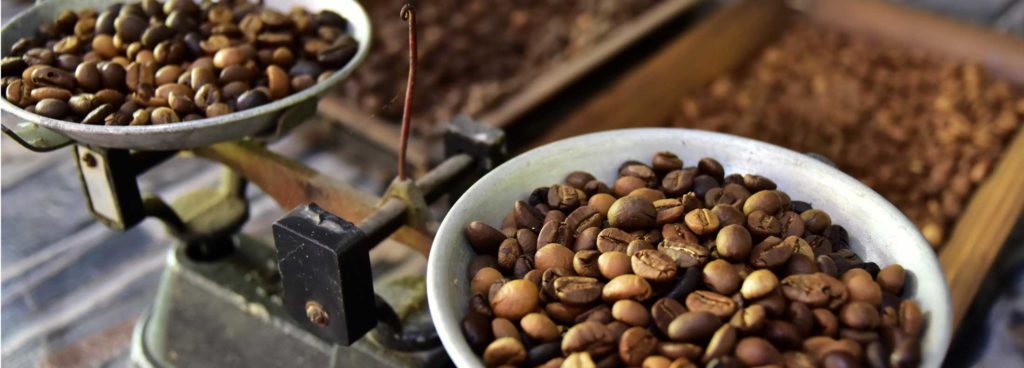
Markets
Smallholder coffee growers sell their produce in fragmented and exploitative local markets. A survey from Chikmagalur and Hassan districts (Karnataka) found that over 90% of growers sold their produce at the farm gate7 Babu, P. (2019). Value Chain Upgrading Strategies for Integration of Indian Small Coffee Growers in Global Coffee Value Chain. Economic Affairs, 64(4).. In our interviews, we found approximately 50% of farmers (N=140) sell their coffee to local traders or markets8Krishi Taranga coffee growers (2021). Qualitative farmer surveys: Round 1. 6 Jul.. There are several reasons why these selling conditions are less than ideal. This includes a lack of infrastructure: smallholders, who deal with relatively small amounts of coffee, usually sell directly to a local trader or agent who pays them on the spot and bears the costs of transporting the coffee to the curing agent. This is where smallholders often lose value on their coffee as local traders set the price for the farmers’ produce.
Another concern is high price variability and lack of transparency. Local traders set coffee prices according to international coffee trends. When buying from farmers on the ground, this price is adjusted based on the quality of the product, which is measured by moisture and out-turn tests. However, the degree to which prices are adjusted based on these metrics is not always clear, leaving farmers feeling frustrated.
“Traders will not buy coffee at existing coffee prices. When traders provide information about prices [they say] it will be more, but [when it comes to] selling the coffee, traders fix a certain [lower] rate and give the unnecessary reason that the moisture content is not good.”
Interview with A.G Nannaiah, Virajpete, near Madikeri
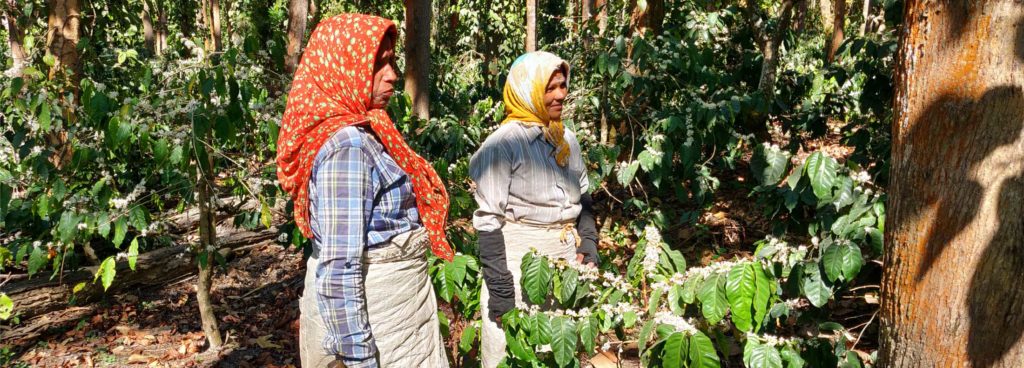
What are we doing?
As part of the CKT hotline, we offer a free price feature which farmers access to listen to daily local and international price information. This is our most used feature, indicating interest in price information. However, overall usage of the hotline is low. We are currently exploring alternative ways of delivering price information to our farmer base, in the hope of reducing frictions and increasing the use of market price tools and information. Lines of relevant inquiry include exploring the use of WhatsApp and SMS to provide price alerts.
To explore ways of reducing price variability, which contributes to income volatility and uncertainty, the PxD team is running a market linkages pilot with the Sustainable Trade Initiative (IDH) in Karnataka. IDH will facilitate contracts between interested buyers and smallholder growers, in which buyers commit to purchasing produce (granted it meets certain quality conditions) at a fixed price. PxD will support growers in meeting these conditions by disseminating relevant agricultural information.
Gender
“My wife visits the estate whenever it is necessary, for example if I am away from the station she looks after things, and after the harvest and the coffee is dried, she weighs it and keeps a record of the quantity of coffee available after it has dried.”
Interview with Virajpete Madhayya, Madikeri
As per India’s Census 2011, coffee plantations were major employers of women workers in Karnataka; out of a total of 480,000 average daily workers employed in coffee plantations, 62% were women. Women appear to be employed for specific activities such as coffee picking, weed management, and applying manure and chemical fertilizers 9Joy, C.V. (2004). Small Coffee Growers of Sulthan Bathery, Wayanad Kerala Research Programme on Local Level Development Centre for Development Studies Thiruvananthapuram. [online] Centre for Development Studies, Kerala, India: Centre for Development Studies, pp.1–43. Available at: http://www.cds.ac.in/krpcds/publication/downloads/83.pdf [Accessed 29 Oct. 2021].. In our interviews with women, we found that women are heavily involved in specific coffee-related activities, including weeding and coffee picking. While women are generally not primary decision-makers for most activities, they appear to be included in the decision-making process. We also learned that women are often part of community groups including self-help groups like “Swasahaya Sangha” (for more information, see our blog post on women’s groups).
What are we doing?
We would like to explore the role of women’s groups and whether these can be leveraged to increase engagement with, and provide relevant support to, female farmers. Evidence from our other programs and the literature suggests that women can increase their collective knowledge and engagement through participating in community groups. The fact that many women in our service are generally involved in day-to-day decision-making suggests that there is room to cater specifically to the areas in which women work. This includes exploring value chains adjacent to coffee cultivation where women may have more involvement, for example, intercrops like spices.
Looking forward
The landscape analysis helped our team gain a broader understanding of the range of challenges and opportunities that exist within the coffee sector in Southern India. In doing so, we have been able to strategize and set evidence-based priorities. This includes focusing on addressing weather-related risks through a pilot to test the impact of providing customized weather forecasts to coffee growers, and a market-focused pilot with IDH.
At the same time, we are also scaling our program with the support of the Walmart Foundation. This includes expanding to another coffee-growing state, Andhra Pradesh. Coffee growers in Andhra Pradesh are different from those in Karnataka, as they are primarily based in tribal regions and practice more traditional farming. We are excited to learn more about coffee growers in this region and adapt our existing service to address their unique information needs.

PxD is building a free weather forecast product for cotton farmers in Pakistan’s Punjab Province to be launched in March, ahead of Kharif – South Asia’s summer planting season. The service will be launched in phases and will ultimately serve 490,000 smallholder cotton farmers across the province.
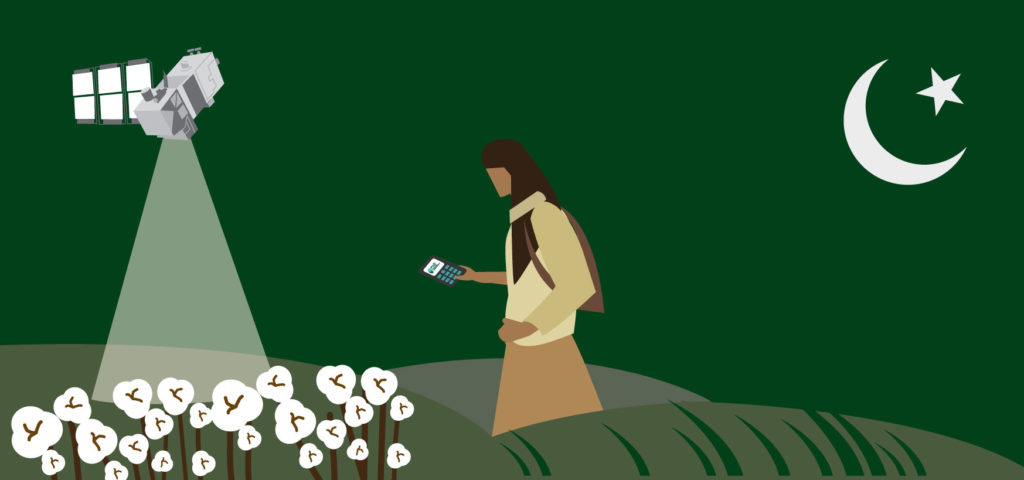
We are excited by the pioneering potential of this product for distributing weather information to inform decision-making on the part of poor, rural farmers in Pakistan’s cotton belt. Moreover, we have been excited to engage in an intentional process of product design from which we have learned a great deal, and which we anticipate will inform the further iteration and development of weather programming and forecast provision across PxD’s geographies, and beyond.
As we have iterated this new product, we have grappled with wide-ranging design possibilities that could increase usefulness and impact. Guiding questions include: Is it more valuable for farmers to receive good weather information – as is typically offered – or is it more valuable to complement forecast information with digital agronomic recommendations (a core PxD competence)? During what stages of the crop cycle, and for which key decision-points, is weather advisory most valued and impactful? At what frequency should advisory be given? How does one communicate probabilities in a way that is accessible and practical for farmers? How does a farmers’ relationship with the weather – and informational needs – differ based on whether their crops are irrigated or rain-fed?
To guide more informed product design decisions, in November the Pakistan team commenced with a set of end-user interviews with 55 cotton and wheat farmers. While 71% of wheat farmers cited access to weather forecasting information, only 45% of cotton farmers surveyed reported access to weather information. When asked if weather information “helped in planning”, 88 and 86% of cotton and wheat respondents respectively responded in the affirmative. This finding buttresses an earlier survey of wheat farmers users in Pakistan where, in response to the question “What agriculture-related information do you need for your wheat crop during the next month?”, 18.5% of respondents cited weather. When canvassing end-users in November, farmer users were asked to “Please list the types of weather challenges you have experienced” in the three years prior to being surveyed. Forty-three percent of respondents who reported experiencing weather-related challenges cited heavy rainfall and 30% reported high winds.
These types of weather incidents can be very costly for smallholder farmers with limited resources. Inundation washes away expensive inputs, creates mud that blocks sprouting crops, and creates conditions conducive to disease, while wind can destroy or severely damage crops throughout the cropping cycle. Further, when prompted to answer “Out of these weather challenges, which three have the largest impact on your crop costs and yields”, pest management was reported as the most common answer. Many pests and diseases thrive in particular weather conditions and can proliferate quickly if conditions are optimal. This suggests that a combination of advisory and weather forecasting information alerting farmers to be on the lookout for pests and to initiate pesticide application decisions sooner could be valuable as a means for reducing pest damage.
To test certain features of our Kharif forecasting products in practice, the PxD Pakistan team took advantage of the ongoing Rabi wheat season (winter planting cycle) to launch two minimum viable products (MVPs) as an AB test. This round of product development was delivered to roughly 2,000 wheat farmers, with each pilot product servicing approximately 1,000 farmers, respectively. The first treatment entailed a simple 48-hour weather-only forecast delivered via SMS and robocall. The second treatment issued an equivalent 48-hour weather forecast to 1,500 wheat farmers, complemented by recommendations on how to adjust one’s irrigation accordingly.
In February, when users have been exposed to the MVP services for two months, they will be surveyed to obtain richer feedback. This survey will aim to answer the fundamental question about whether farmers value weather-linked advisory over weather-only messages. If weather-only is the clear preference, this may suggest that farmers are generally able to connect actions to relevant weather. In the event that farmers do not explicitly need advisory as a complement to forecasting information, this would greatly simplify product development. Secondary questions source farmers’ views on the frequency and relevance of distributed messages. Lastly, under the hypothesis that farmers will prefer advisory linked to weather information, in-field focus groups will be conducted in March to expose farmers to an array of pre-recorded agronomic recommendations and message framings. Feedback from farmers will be used to inform the iteration of advisory scripts and message framing as we work to maximize comprehension, particularly relating to the communication of uncertainties and probabilities, and address potential barriers to adoption.
Another core challenge in developing this product is the quality of the weather forecasts themselves. The existing forecast services in Punjab tend not to be designed with the end user’s needs in mind. Three services in Punjab, Pakistan exemplify usability issues: the first requires user-initiated, user-paid inbound calls; the second requires internet access; and the third is only available to subscribers of a particular telecoms company.
To overcome these types of challenges, PxD is partnering with the private forecast provider CFAN (Climate Forecast Applications Network) to develop calibrated custom forecasts. CFAN is a leading forecast provider, with temperature, cyclone, and severe weather products across North America, Central America, and Asia, and extensive experience in forecasting South Asia weather dynamics. In addition to giving PxD the flexibility to adapt CFAN’s data streams according to our users’ needs, we are using this partnership to transparently assess the magnitude of upfront costs required to build a forecast system.
Learnings from these research activities, coupled with insights generated by our collaboration with CFAN, will inform the final design of our Kharif weather forecasting product for cotton farmers. Once this product is up and running, the focus will shift to impact evaluation, including pick-up rates, behavior changes, and forecast accuracy. Pending a review of such impact outcomes, and funding considerations, the product will be further developed to cover the Rabi season and potentially scaled to additional countries.
This Kharif season, we are thrilled at the prospect of hundreds of thousands of Punjabi smallholder cotton farmers witnessing less fertilizer – and by implication, fewer resources – washed away or harvests inundated by unexpected rains, deploying more effective irrigation tailored to the forecast, and incurring fewer crop losses due to heavy rains and winds. When we asked our PxD Pakistan agronomist about the potential impact of this product, she said: “This product will reduce farming risks and expenses, and increase what is usually a farmer’s sole source of income – allowing for more investment into farming or money for personal expenses”. We are also excited about the potential for this product to serve as a template for iterative product and design process management, and proof of concept, which others may learn from and implement in other settings.
Mark Tamming is an Associate in the London Office of Oliver Wyman, a management consulting firm. Oliver Wyman generously sponsored Mark in joining PxD as an ‘extern’ for three months on PxD’s product team. Shams Sadiq is a Research Associate on the PxD Pakistan team. We thank Khushbakht Jamal, Mahroz Haider, Jagori Chatterjee, Fatima Fida, Adeel Shafqat, Omer Qasim, Hannah Timmis, and the broader PxD Pakistan team who offered valuable contributions to this post and the product development that sits behind it.
Last week delegates convened in Glasgow at the 26th Conference of the Parties (COP26) to the United Nations Framework Convention on Climate Change to engage in the difficult task of negotiating an offramp to climate catastrophe. The vast majority of PxD’s 5.2 million users are poor farmers who confront myriad – and reinforcing – challenges linked to climate change, food security, and poverty. We are excited to have secured new funding to pursue research opportunities for climate mitigation innovations to benefit smallholder farmers.
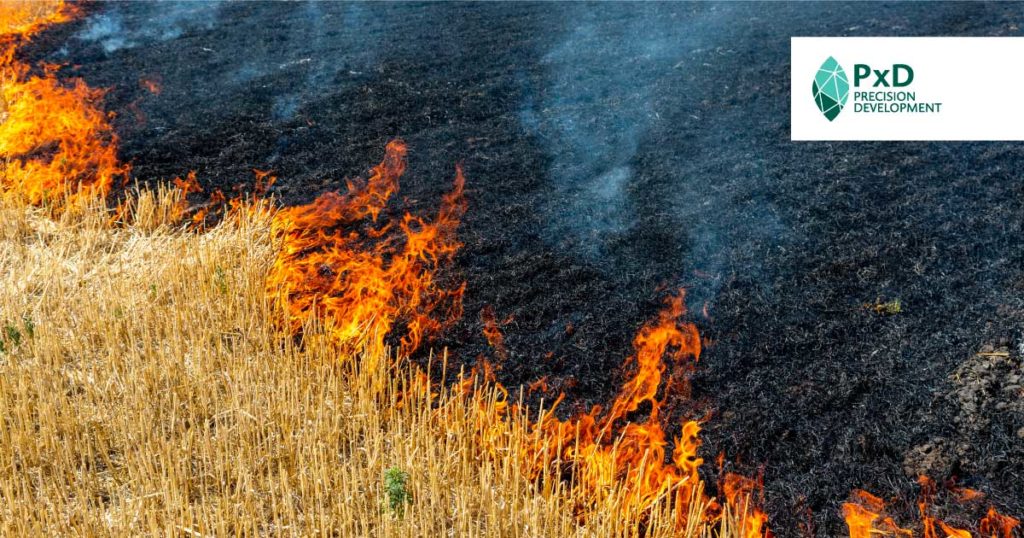
In this post Dina Rodrigues, Global Research Support Associate, Caitlin McKee, Assistant Director of Research, and Tomoko Harigaya, Chief Economist and Director of Research, present how PxD thinks about the complementarity of research, service design, service delivery, the evaluation of impact, and development practice. We assess how our programming can promote behavior change to advance climate-related goals, and we lay out opportunities for new research.
As we work to enhance our service offerings and research activities, to identify new opportunities for climate innovation, and to assist our users to lead more productive and resilient lives, we are guided by the following principles:
- User benefit first – Smallholder farmers cannot be expected to pay the price for climate mitigation. All climate-friendly advice to smallholder farmers from PxD should support livelihoods and not compromise agricultural yields or smallholders’ income. If there are evidence gaps on farmer benefit, we will explore ways for farmers to be favorably compensated for adopting those practices as an additional source of income.
- Adapt and mitigate – Our ambition is to promote both climate change adaptation (reducing potential damage) and mitigation (tackling the causes) activities.
- Replicate and scale – To fully leverage the advantages of scale, we work to ensure that our advisory services can be replicated across multiple contexts and with a diversity of partners.
The role of research at PxD
PxD’s systems are designed to scale the delivery of customized digital information to individuals and households so that they can act on it to improve their well-being and reduce exposure to risks and disasters such as floods and droughts. Our systems are designed to be scaled; as they scale, average costs fall and we improve the cost-effectiveness of our delivery.
Research is integral to this work. We deploy experiments and other research methods to inform the design of our services (innovation research) and to evaluate our impact (evaluation research). We generate evidence and insights based on a range of activities, from large randomized controlled trials to small-scale pilots. We learn from experiments that show statistically significant results and null experimental results, as well as through the analysis of descriptive and qualitative data.
PxD’s goal is to generate large aggregate impacts for the poor, and the role of research at PxD is to draw insights from empirical data, existing evidence, scientific knowledge, and theories to:
- Contribute to the development of PxD by identifying impact opportunities through the generation of insights into technological change, partnerships, scenario planning, and strategic choice, etc.
- Inform the design of programs and PxD’s investment decisions.
- Rigorously test and iterate ideas and assumptions.
- Evaluate and quantify the impact of our programs.
- Increase our understanding of the link between what we can observe and the ultimate outcomes we care about.
- Contribute to a broader knowledge base for practitioners, policymakers, and researchers.
In this way, our researchers support and collaborate with teams across the organization to enable efficient and effective learning through rigorous research to advance PxD’s goals.
Meeting the challenge of the age
We are intensifying our efforts to provide information to smallholder farmers that will allow them to make informed decisions to reduce the risks that climate change presents to their livelihoods and to enjoin their farming and land management activities in the fight against climate change. PxD is focusing on identifying interventions that can improve smallholder livelihoods whilst incorporating climate adaptation and mitigation efforts into our existing services. A key component of this is identifying feasible methods for measuring outcomes and program impacts on farmer welfare and the climate. A further component of our research agenda is to iteratively develop, refine, and test these innovations at scale.
Climate-smart advisory, adaptation, and mitigation efforts are already embedded into our programs across all the geographies we work in, as well as into the day-to-day agricultural activities that PxD farmers carry out. We focus both on climate change adaptation (reducing potential damage) and climate change mitigation (tackling the causes), as the activities and approaches are distinct.
1. Climate Change Adaptation
Adaptation efforts focus on anticipating the adverse effects of climate change and taking appropriate action to minimize potential damage for those most likely to be adversely affected, whilst managing and, hopefully, reducing climate-related risks. Ultimately, the aim of climate adaptation is to enhance the resilience of the individuals, households, and communities most vulnerable to negative climate shocks. These efforts generally involve the use of dynamic, local information to adapt their practices to climate shocks and behavior change and the adoption of new technology to increase resilience. At PxD we are increasingly asking questions such as: How climate-vulnerable are the farmers that use our services; What are the consequences of climate change that are affecting smallholder farmers’ lives; And how can we reduce the welfare loss that individual farmers and communities experience, or are likely to experience, because of climate change?
Weather uncertainty is one of the biggest agricultural risks faced by smallholder farmers. Climate change has increased weather variability and unpredictability in many parts of the world, imposing greater risks on agricultural production. These challenges are exacerbated by a lack of appropriate infrastructure and insufficient ground validation to provide accurate weather forecasts in many parts of the Global South.
PxD programs include adaptation efforts to reduce weather-related risk and uncertainty caused by climate change. One such example is the promotion of flood-tolerant seeds in the state of Odisha, India, on PxD’s largest Indian service, Ama Krushi, which currently has over one million users. Two-thirds of Ama Krushi farmers have experienced significant crop damage due to weather shocks and, of these, 57% experienced flooding. PxD’s climate adaptation efforts included experimentation with simplified, targeted Interactive Voice Response (IVR) messages to nudge the adoption of flood-tolerant rice varieties. We found that our simplified low-cost messaging significantly increased low and medium land types farmers’ adoption of flood-tolerant seeds. On average, these farmers were 2.6 percentage points more likely to plant flood-resilient seeds after receiving a message, a 25% increase over the control group mean adoption rate of 10.4%.
In another geographic context, in Punjab, Pakistan, PxD is working on new product design to further customize our advisory by integrating granular weather data into existing services. PxD will use enhanced weather models to inform farmers of local conditions, linking weather conditions to relevant agricultural advisory. Existing forecasts in Pakistan mainly lack both the granularity and the accessibility to meet the needs of smallholder farmers and support day-to-day farming decisions. Via partnership with experts in satellite-based weather prediction models, PxD will develop a granular forecast at the local tehsil level, and PxD will leverage its communication for behavior change expertise, disseminating this information via SMS and voice. In addition, we are conducting user research and consulting agronomists to design and test agricultural advisory that is linked to weather forecasts.
Finally, when weather calamities are anticipated, many PxD services advise farmers on what they can do to minimize crop damage. In Odisha and West Bengal, for example, our services inform farmers of impending cyclones, advise them about actions they can take to protect their crops in the field, or encourage them to bring in their produce from the field early, if appropriate. Our advisory can also promote appropriate post-harvest and storage practices in contexts where a farmer may otherwise not have expected to take action.
Example of paddy/rice crop advisory for deficit rainfall
English Translation:
Namaskar. Welcome to the ‘Ama Krushi’ free Agriculture Information service of Department of Agriculture, Government of Odisha. Paddy crop is affected by current scanty rainfall situation in many districts of Odisha. Today we will give some advisory to manage paddy crop due to scanty rainfall situation. Do not practice Beushaning in rice, if the crop is more than 45 days old. Don’t wait for rainfall and carry out hand weeding. In line direct sown paddy, use manual weeder if optimum soil moisture is present. Don’t go for Beushaning in areas where large deficit of rainfall has been seen. Go for hand weeding and gap filling using seedling of same age or clonal tillers to have a uniform distribution of plant after optimum rainfall is received. If basal fertilizer is not applied in direct sown paddy than apply 38-kg of DAP/acre, 20-kg of Urea/acre, 14-kg of MOP/acre., 4-kg of Borax/acre and 10-kg of Zinc Sulphate/acre. Strengthen the field bunds and close the holes to check seepage loss. For delayed transplanting seedlings up to 45 and 60-70 days old can be transplanted in case of medium and late duration rice varieties, respectively without much reduction in yield. Transplant the old seedling in puddled soil at shallow depth with closer spacing of 15 x15 cm and 4-5 seedlings per hill. Apply 50 % Nitrogen fertilizer along with other recommended fertilizer during transplanting. Thank You.
Example of paddy/rice crop advisory for excess rainfall
English Translation:
Namaskar. Welcome to the ‘Ama Krushi’ free Agriculture Information service of Department of Agriculture, Government of Odisha. Today we will discuss about some crop management strategies after excess rainfall due to low pressure and depression in Bay of Bengal. Drain out excess water from paddy field if possible. If the paddy crop is under submergence temporarily, apply 10-12 kg of MOP after rainwater recedes. Don’t apply fertilizer and wait for new tillers to come if paddy crop is affected largely due to complete submergence. If crop is lodged due to excess rain and wind, then try to keep it upright by binding few hills. There are chances of increase in chaffy grains if the crop is in panicle emergence stage. To minimize chaffy grains in the panicle spray Boron 20 % (Folibor/Solubor) @ 1-1.5 gram/litre or Borax @ 2-2.5 gram/litre of water. Spray fertilizers or pesticides during afternoon hours instead of morning hours if the crop is in flowering stage. Thank You.
2. Climate Change Mitigation
Mitigation efforts focus on tackling the causes of climate change to reduce the flow of heat-trapping greenhouse gases (GHG) and other climate and air pollutants, like black carbon soot, into the atmosphere. This can be achieved either by reducing emissions of climate pollutants or by increasing carbon sequestration in the soil, forests, and oceans. When it comes to smallholder farmers, climate mitigation focuses on changes in agricultural and land management practices and the adoption of new technologies or farming behaviors that can contribute to reducing emissions or increasing sequestration at scale. At PxD, we are increasingly preoccupied with ensuring that such behavior changes are also beneficial for the individual farmers and communities we serve.
Some agricultural practices are likely to contribute both to poverty alleviation and climate mitigation if they result in increases in agricultural outputs or income. One such example is promoting the optimal and timely application of nitrogen-based fertilizers. Most PxD advisory services, across our various geographies, include recommendations on the optimal application of planting and/or top-down fertilizer. Our agronomy teams have identified overuse of nitrogen fertilization and underuse of other required fertilizers with smallholders who tend to rice paddies and cotton fields in the Indian states of Odisha and Gujarat, respectively. Whilst nitrogen fertilization is an important component of crop production, crops can only efficiently absorb a finite amount of nitrogen. Nitrogen applied in excess contributes to water and atmospheric pollution in the form of nitrates or nitrous oxide. Emissions tend to be proportional to the amount of fertilizer used and the concentration of nitrogen in the product. Precise application of nitrogen fertilizers has the potential to cut down farming costs if farmers need to purchase less fertilizer, hence improving smallholders’ agricultural income whilst curbing nitrous oxide emissions. We are exploring user-friendly tools, such as leaf color charts, to support farmers to optimize their fertilizer application.
In addition, several of our services in Africa, including MoA-Info in Kenya, push-calls in Nigeria, and UCAT-Uganda, advise farmers to cover crops to slow erosion, improve soil moisture, and prevent pests and disease outbreaks. PxD farmers across most of our geographies also control soil erosion via techniques such as terracing or contour plowing. These methods are likely to improve yields via a general enhancement of soil conditions whilst increasing soil propensity for carbon sequestration by slowing erosion.
However, some agricultural practices have unclear effects on yields, agricultural income, or climate outcomes. Most worryingly, many behavior changes that present opportunities for climate mitigation put a burden on smallholder farmers. In these cases, decision-makers, researchers, and practitioners must identify ways to compensate farmers for the social benefits they generate by adopting those behavior changes, whilst guaranteeing an immediate private return for early adopters. This may include payment schemes, such as conditional cash transfers, or subsidies for improved technologies, but further research is needed to understand what kind of incentives and measurement techniques are likely to work in various settings.
Opportunities for new research
In partnership with the Institute for Governance & Sustainable Development (IGSD), PxD will undertake exploratory activities with a specific focus on climate change mitigation in addition to poverty alleviation. We are excited to scope our existing programs and partnerships to identify:
- Opportunities for scalable climate mitigation innovations.
- Evidence and measurement gaps.
- How we can leverage soil science, remote sensing, and soil sensor technology to improve agricultural productivity and generate climate mitigation innovations.
- Barriers and opportunities in terms of measurement, adoption, and smallholder behavior change.
The aim of this work is to lay a foundation to ultimately develop, test, and scale innovations such as payment schemes or cash-transfer approaches that can simultaneously address climate change and reduce poverty.
On a preliminary basis, we have identified the following potential climate mitigation areas:
- Reducing black carbon emissions from crop or biomass burning
- Reducing nitrous oxide emissions from fertilizer overuse
- Enhancing soil carbon sequestration
- Protecting and enhancing carbon sinks through forestry
- Reducing methane emissions from livestock, dairy, and rice.
Within each of these areas, PxD plans to scope relevant agricultural activities practiced by farmers engaged with our advisory services across all our geographies, relevant partner capabilities, and potential external consultants. Based on this mapping exercise, we aim to identify specific technologies and farming practices that can improve climate mitigation outcomes at scale in conjunction with relevant measurement outcomes (e.g., soil carbon, soil characteristics, and GHG and climate pollutant emissions reductions).
PxD is committed to always putting the welfare of smallholders and our contribution to poverty alleviation first. As an organization that works with over five million users across a variety of settings, PxD is well-placed to advance the knowledge frontier through rigorous experimental applied research. Our aim is to enhance the resiliency of smallholder farming households through the diffusion of information to promote the adoption of new technologies and climate-smart agricultural practices. We are excited to implement this nascent research agenda and enjoin the activities of millions of smallholders as agents of change in plotting a more resilient future.
We will share our learnings in future posts!

Make an Impact Today

